Paul van Yperen's Blog, page 253
November 15, 2018
Pauline Frederick
Pauline Frederick (1883-1938) was an American stage and film actress. Frederick made a name for herself in the theatre and had already passed thirty when she became successful in Hollywood. In the era of the silent film she was one of the most powerful actresses in the film industry.
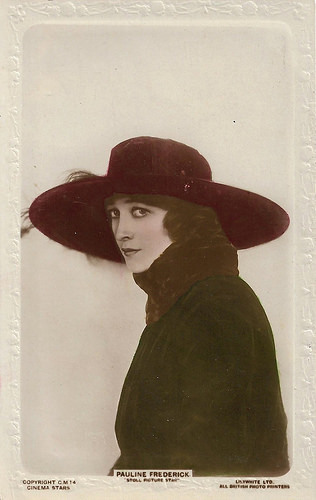
British postcard in the Cinema Stars series by Lilywhite Ltd., no. C.M. 14. Photo: Stoll Pictures.
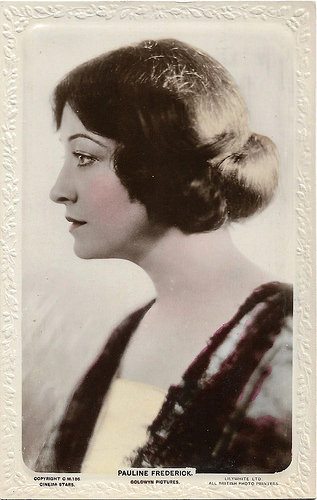
British postcard in the Cinema Stars series by Lilywhite Ltd., no. C.M. 186. Photo: Goldwyn Pictures.
Sophisticated or demanding, classy women and femme fatales
Pauline Frederick was born Pauline Beatrice Libbey in 1883 in Boston, USA, as the daughter of a prosperous couple, Richard O. and Loretta C. Libbey.
Her father worked as a yardmaster for the Old Colony Railroad before becoming a salesman. Her parents separated when she was a toddler and Frederick was raised primarily by her mother to whom she remained close for the remainder of her life.
As a child, Frederick was already interested in show business. Inspired by the theatre, she took singing lessons, and at the age of 19, she was accepted at the Boston Music Hall. When she got the thread, she packed her suitcases and moved with her mother to New York City.
Then known as Pauline Libby, she changed her surname to 'Frederick'. All this to the displeasure of her father, who got his daughter removed from his will in revenge. She legally changed her name to Pauline Frederick in 1908. In New York, Frederick started as a choir girl, but soon she made her debut on Broadway. Her first breakthrough came in 1904 when as an understudy she had to replace the lead actress in It Happened in Norland.
Frederick's heart lay with melodramas, and in the end she chose to neglect the opera. In 1908, Frederick became infertile because of a serious car accident. A year later she married Frank Mills Andrews. During this two-year marriage she stopped acting. In 1913, she secured her success when she returned to the stage with the leading role in Joseph and His Brethren.
In 1914, Pauline Frederick was hired by the film studio Famous Players and made her film debut in The Eternal City (Hugh Ford, Edwin S. Porter, 1915), a religious drama that was shot in Rome just before the outbreak of the First World War. Frederick saw the film industry as a temporary get-away, but encouraged by the success of The Eternal City she signed a contract.
Although she had already passed 30, she became one of the biggest stars in the silent film period. She played mainly sophisticated or demanding, classy women and femme fatales.
On the set of Nannette of the Wilds (Joseph Kaufman, 1916), the film that critics have renamed the worst of her career, she met actor Willard Mack. They fell in love and married in September 1917.
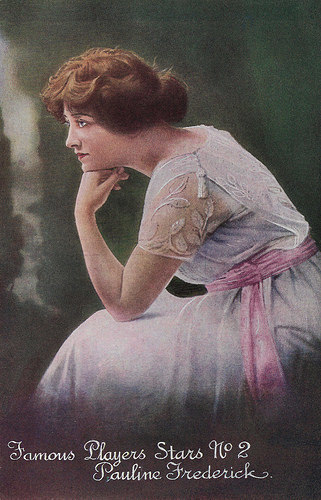
British postcard in the Famous Players Stars Series, no. 2.
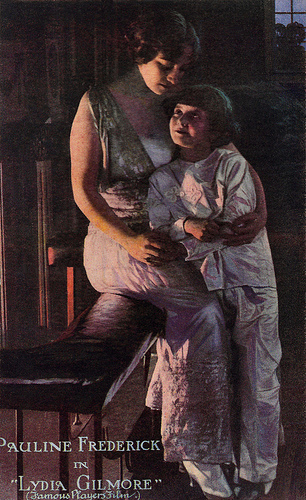
British postcard. Photo: Famous Players Film. Publicity still of Pauline Frederick in Lydia Gilmore (Hugh Ford, Edwin S. Porter, 1915).
A role model and style icon for elder women
In 1919, Pauline Frederick signed a contract with Goldwyn Pictures. Critics agreed that she was assigned roles here that were more suitable for her. The budget of her films was larger and the films were better received in terms of quality. Although her career ran smoothly, her private life was a disaster. Mack was a violent alcoholic and drug addict who regularly mistreated his wife. In 1919 she applied for a divorce.
As a result of the relocation of Goldwyn, Frederick moved to California in 1920. That same year she played in Madame X (Frank Lloyd, 1920), the film she became best known for. Despite the success she enjoyed at Goldwyn, she left the studio for a contract with Robertson-Cole, where she received a fixed salary of $7,000 per week. Her move to Robertson-Cole was a misstep in her career. Most films flopped and reviewers spoke negatively about them. In 1922 her contract was terminated and she returned to the stage.
In 1924, she was hired by the Vitagraph Company, where she achieved success in films such as Three Women (Ernst Lubitsch, 1924) with May McAvoy and Marie Prevost, and Smouldering Fires (Clarence Brown, 1925) with Laura La Plante and Malcolm McGregor. Frederick became a role model and style icon for elder women. After a short time she left the studio to go on tour. In March 1927, she received some of her better reviews when she appeared in the play Madame X in London.
After her return to Hollywood, she did not manage to become as successful as before, but the film roles kept on coming. In 1928, Frederick's first sound film, On Trial (Archie Mayo, 1928), was released. Her voice was poorly received, but film historians blame this on the bad sound techniques. Technological progress went smoothly and eventually the actress made a good transition to the new film medium. She was cast as Joan Crawford's mother in This Modern Age (Nick Grinde, 1931). In spite of this, Frederick lost her prestige. Actors were massively exchanged for new talent. Similarly for Frederick, who managed to get film roles only with difficulty.
In the 1930s, Frederick underwent one setback after another. She returned to Broadway in 1932 in When the Bough Breaks, but because of the Great Depression she had trouble getting roles. Frederick filed for bankruptcy in 1933. She was in several short-term marriages and in the autumn of 1934 her fifth husband, Joseph Marmon, died of cancer. In the meantime she took care of her mother, whose health seriously deteriorated.
After her last theatre appearance in New York in 1936, she returned to Hollywood. Her final film was Thank You, Mr. Moto (Norman Foster, 1937) with Peter Lorre in the title role. Her mother died in February 1938 and Frederick suffered from severe asthma attacks. She did not recover from this and passed away in September 1938 at the age of 55.
Greta the Groat writes about her: “Pauline Frederick is one of the most interesting and individual stars of the American silent screen. In an era of gentle and sweet heroines--even among the 'emotional actresses', Frederick stood out with her dramatic looks, commanding presence and worldly characters. While never a top box office draw, Frederick was always something of a connoisseur's star, and her subtle and cinematic acting technique was widely admired both by audiences and within the industry. Unfortunately for modern audiences, only a handful of her many silent films survive. Those survivors, however, appear to have been among her best and most memorable, though they give us a somewhat skewed and limited view of her career.”
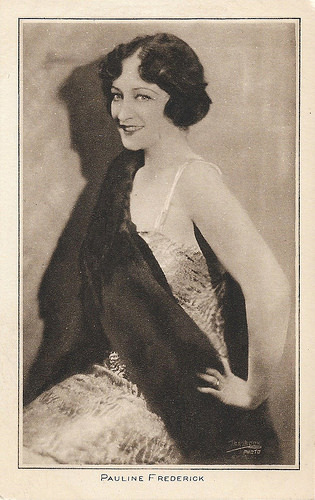
British postcard in the 'Pictures' Portrait Gallery, no. 106.
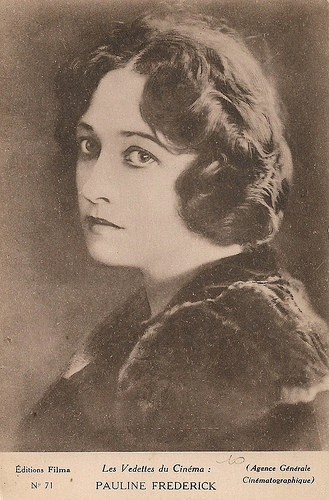
French postcard in the 'Les Vedettes du Cinéma' series by Editions Filma, no. 71. Photo: Agence Générale Cinématographique.
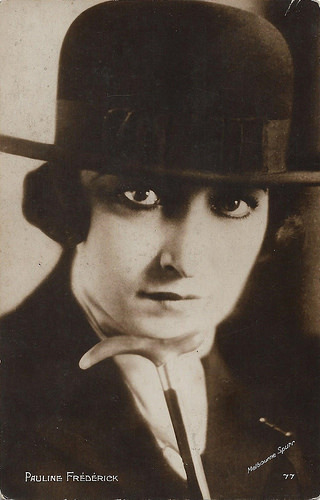
French postcard by Editions Cinémagazine, no. 77. Photo: Melbourne Spurr.
Sources: Greta the Groat (The Pauline Frederick Website), Wikipedia (Dutch, English and German) and .

British postcard in the Cinema Stars series by Lilywhite Ltd., no. C.M. 14. Photo: Stoll Pictures.

British postcard in the Cinema Stars series by Lilywhite Ltd., no. C.M. 186. Photo: Goldwyn Pictures.
Sophisticated or demanding, classy women and femme fatales
Pauline Frederick was born Pauline Beatrice Libbey in 1883 in Boston, USA, as the daughter of a prosperous couple, Richard O. and Loretta C. Libbey.
Her father worked as a yardmaster for the Old Colony Railroad before becoming a salesman. Her parents separated when she was a toddler and Frederick was raised primarily by her mother to whom she remained close for the remainder of her life.
As a child, Frederick was already interested in show business. Inspired by the theatre, she took singing lessons, and at the age of 19, she was accepted at the Boston Music Hall. When she got the thread, she packed her suitcases and moved with her mother to New York City.
Then known as Pauline Libby, she changed her surname to 'Frederick'. All this to the displeasure of her father, who got his daughter removed from his will in revenge. She legally changed her name to Pauline Frederick in 1908. In New York, Frederick started as a choir girl, but soon she made her debut on Broadway. Her first breakthrough came in 1904 when as an understudy she had to replace the lead actress in It Happened in Norland.
Frederick's heart lay with melodramas, and in the end she chose to neglect the opera. In 1908, Frederick became infertile because of a serious car accident. A year later she married Frank Mills Andrews. During this two-year marriage she stopped acting. In 1913, she secured her success when she returned to the stage with the leading role in Joseph and His Brethren.
In 1914, Pauline Frederick was hired by the film studio Famous Players and made her film debut in The Eternal City (Hugh Ford, Edwin S. Porter, 1915), a religious drama that was shot in Rome just before the outbreak of the First World War. Frederick saw the film industry as a temporary get-away, but encouraged by the success of The Eternal City she signed a contract.
Although she had already passed 30, she became one of the biggest stars in the silent film period. She played mainly sophisticated or demanding, classy women and femme fatales.
On the set of Nannette of the Wilds (Joseph Kaufman, 1916), the film that critics have renamed the worst of her career, she met actor Willard Mack. They fell in love and married in September 1917.

British postcard in the Famous Players Stars Series, no. 2.

British postcard. Photo: Famous Players Film. Publicity still of Pauline Frederick in Lydia Gilmore (Hugh Ford, Edwin S. Porter, 1915).
A role model and style icon for elder women
In 1919, Pauline Frederick signed a contract with Goldwyn Pictures. Critics agreed that she was assigned roles here that were more suitable for her. The budget of her films was larger and the films were better received in terms of quality. Although her career ran smoothly, her private life was a disaster. Mack was a violent alcoholic and drug addict who regularly mistreated his wife. In 1919 she applied for a divorce.
As a result of the relocation of Goldwyn, Frederick moved to California in 1920. That same year she played in Madame X (Frank Lloyd, 1920), the film she became best known for. Despite the success she enjoyed at Goldwyn, she left the studio for a contract with Robertson-Cole, where she received a fixed salary of $7,000 per week. Her move to Robertson-Cole was a misstep in her career. Most films flopped and reviewers spoke negatively about them. In 1922 her contract was terminated and she returned to the stage.
In 1924, she was hired by the Vitagraph Company, where she achieved success in films such as Three Women (Ernst Lubitsch, 1924) with May McAvoy and Marie Prevost, and Smouldering Fires (Clarence Brown, 1925) with Laura La Plante and Malcolm McGregor. Frederick became a role model and style icon for elder women. After a short time she left the studio to go on tour. In March 1927, she received some of her better reviews when she appeared in the play Madame X in London.
After her return to Hollywood, she did not manage to become as successful as before, but the film roles kept on coming. In 1928, Frederick's first sound film, On Trial (Archie Mayo, 1928), was released. Her voice was poorly received, but film historians blame this on the bad sound techniques. Technological progress went smoothly and eventually the actress made a good transition to the new film medium. She was cast as Joan Crawford's mother in This Modern Age (Nick Grinde, 1931). In spite of this, Frederick lost her prestige. Actors were massively exchanged for new talent. Similarly for Frederick, who managed to get film roles only with difficulty.
In the 1930s, Frederick underwent one setback after another. She returned to Broadway in 1932 in When the Bough Breaks, but because of the Great Depression she had trouble getting roles. Frederick filed for bankruptcy in 1933. She was in several short-term marriages and in the autumn of 1934 her fifth husband, Joseph Marmon, died of cancer. In the meantime she took care of her mother, whose health seriously deteriorated.
After her last theatre appearance in New York in 1936, she returned to Hollywood. Her final film was Thank You, Mr. Moto (Norman Foster, 1937) with Peter Lorre in the title role. Her mother died in February 1938 and Frederick suffered from severe asthma attacks. She did not recover from this and passed away in September 1938 at the age of 55.
Greta the Groat writes about her: “Pauline Frederick is one of the most interesting and individual stars of the American silent screen. In an era of gentle and sweet heroines--even among the 'emotional actresses', Frederick stood out with her dramatic looks, commanding presence and worldly characters. While never a top box office draw, Frederick was always something of a connoisseur's star, and her subtle and cinematic acting technique was widely admired both by audiences and within the industry. Unfortunately for modern audiences, only a handful of her many silent films survive. Those survivors, however, appear to have been among her best and most memorable, though they give us a somewhat skewed and limited view of her career.”

British postcard in the 'Pictures' Portrait Gallery, no. 106.

French postcard in the 'Les Vedettes du Cinéma' series by Editions Filma, no. 71. Photo: Agence Générale Cinématographique.

French postcard by Editions Cinémagazine, no. 77. Photo: Melbourne Spurr.
Sources: Greta the Groat (The Pauline Frederick Website), Wikipedia (Dutch, English and German) and .
Published on November 15, 2018 22:00
November 14, 2018
The King of Kings (1927)
American silent epic The King of Kings (1927) was produced and directed by Cecil B. DeMille. It was the second in DeMille's biblical trilogy, preceded by The Ten Commandments (1923) and followed by The Sign of the Cross (1932). The King of Kings depicts the last weeks of Jesus before his crucifixion and stars H. B. Warner in the lead role. This classic DeMille shows his storytelling talent and his showmanship by delivering a spectacle like no other. The film has two Technicolor sequences, the beginning and the resurrection scene, which use the two-strip process invented by Herbert Kalmus. The King of Kings was the first film that premiered at Grauman's Chinese Theater in Los Angeles on 18 May 1927. The postcards in this post were made in Germany, France and Austria, and the stills were made by William Mortensen with a hand-held camera.
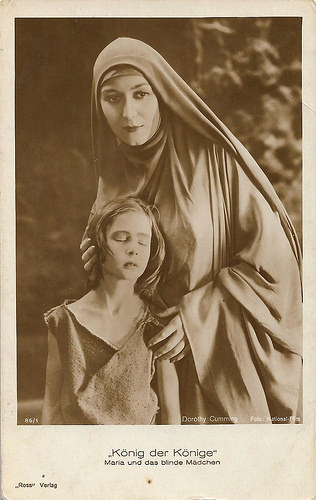
German postcard by Ross Verlag, no. 86/1. Photo: National Film. Dorothy Cumming as the Virgin Mary in Cecil B. deMille's The King of Kings (1927). Caption: Mary and the blind girl.
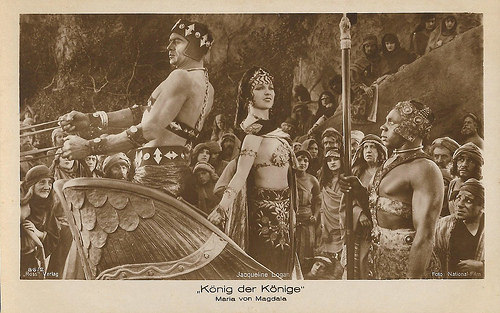
German postcard by Ross Verlag, no. 86/3. Photo: National Film. Postcard for the American silent epic The King of Kings (Cecil B. DeMille, 1927). Caption: Mary Magdalene. The charioteer was played by Noble Johnson, while Jacqueline Logan played Mary Magdalene.
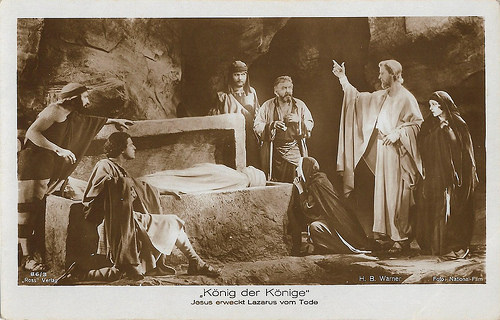
German postcard by Ross Verlag, no. 86/3. Photo: National Film. Postcard for the American silent epic The King of Kings (Cecil B. DeMille, 1927). Caption: Jesus (H.B. Warner) resurrects Lazarus from the Dead.
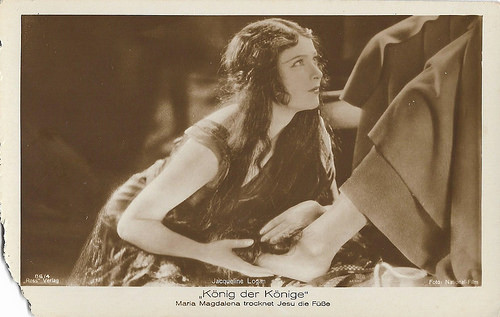
German postcard by Ross Verlag, no. 86/4. Photo: National Film. Postcard for the American silent epic The King of Kings (Cecil B. DeMille, 1927). Caption: Mary Magdalene (Jacqueline Logan) dries Jesus' feet.
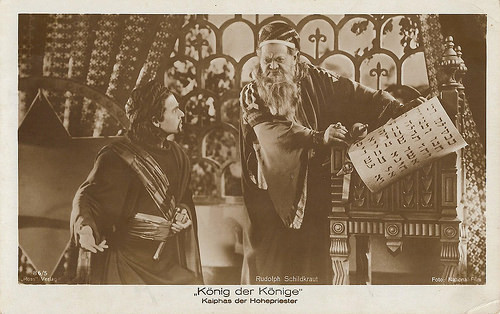
German postcard by Ross Verlag, no. 86/5. Photo: National-Film. Postcard for the American silent epic The King of Kings (Cecil B. DeMille, 1927). Caption: Caiaphas the High Priest of Israel (Rudolph Schildkraut).
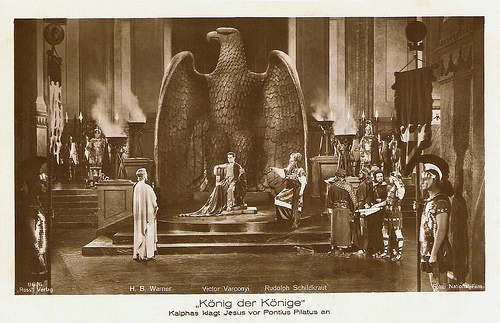
German postcard by Ross Verlag, no. 86/6. Photo: National-Film. Publicity still for King of Kings (Cecil B. De Mille, 1927). Caption: Caiphas accuses Jesus before Pontius Pilate. Victor Varconi as Pontius Pilate the Governor of Judea, H.B. Warner as Jesus and Rudolph Schildkraut as Caiaphas.
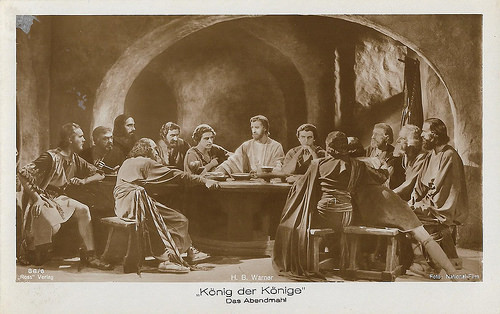
German postcard by Ross Verlag, no. 86/8. Photo: National-Film. Postcard for the American silent epic The King of Kings (Cecil B. DeMille, 1927). Caption: The Last Supper.
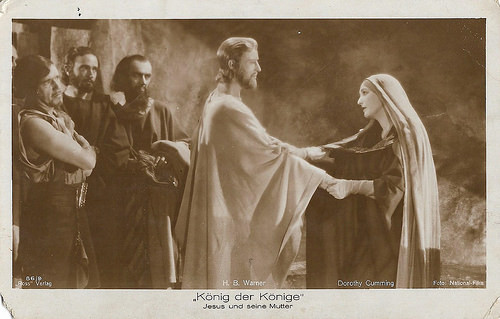
German postcard by Ross Verlag, no. 86/9. Photo: National-Film. Postcard for the American silent epic The King of Kings (Cecil B. DeMille, 1927). Caption: Jesus (H.B. Warner) and his Mother (Dorothy Cumming).
Equal amounts of showmanship and reverence
Hal Erickson at AllMovie : "Having scored big-time box office with his first Biblical epic, The Ten Commandments (1923), Cecil B. DeMille hoped to top this success with his 1927 The King of Kings.
Inasmuch as he was now dealing with the life of Christ, DeMille had to be careful to serve up equal amounts of showmanship and reverence.
The first creative challenge: how to "introduce" Christ in a tasteful manner? The answer: as a blind child is cured through Jesus' intervention, DeMille cuts to the child's point-of-view, slowly fading in on the kindly countenance of H.B. Warner as the Son of Man.
Still, DeMille remained DeMille, especially in his handling of the character of Mary Magdalene (Jacqueline Logan). No longer a tattered streetwalker, Mary Magdalene is now a glamorous courtesan, replete with legions of gorgeous slave girls."
"Once he's gotten his box-office considerations out of the way, DeMille adheres faithfully to the particulars of Jesus' life, betrayal, trial, Crucifixion, and Resurrection. (Again, however, the director improves a bit upon his source material: the storm that follows the Crucifixion is of the same spectacular dimensions as the parting of the Red Sea in Ten Commandments, while the Resurrection is filmed in vibrant Technicolor).
To back up the authenticity of his images, DeMille -- with an assist from scenarist Jeannie Macpherson -- utilizes Scriptural quotes in his subtitles."
The King of Kings is the first film for which the still were made by a hand-held camera. Photographer William Mortenson made four hundred negatives that capture scenes as they were being shot, not posed afterwards.
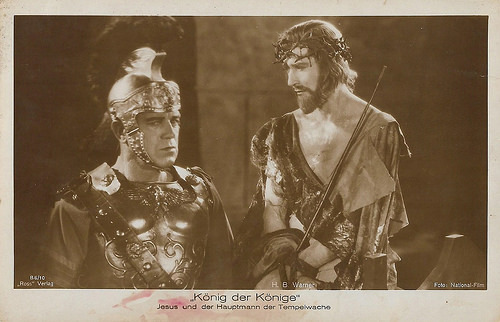
German postcard by Ross Verlag, no. 86/10. Photo: National-Film. Postcard for the American silent epic The King of Kings (Cecil B. DeMille, 1927). Caption: Jesus (H.B. Warner) and the Captain of the Temple Guards (Theodore Kosloff).
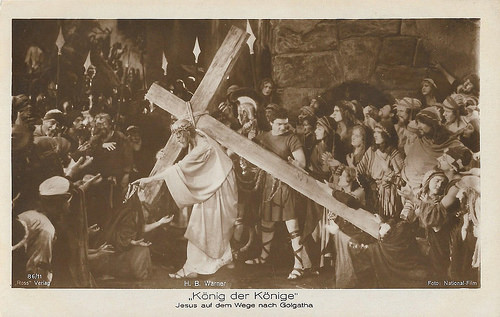
German postcard by Ross Verlag, no. 86/11. Photo: National Film. Postcard for the American silent epic The King of Kings (Cecil B. DeMille, 1927). Caption: Jesus (H.B. Warner) on the way to Golgotha. The man helping to carry the cross could be William Boyd, who played Simon of Cyrene.
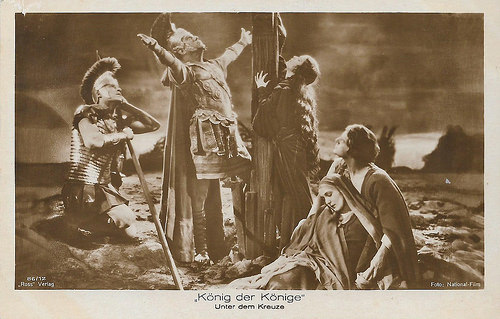
German postcard by Ross Verlag, no. 86/12. Photo: National Film. Postcard for the American silent epic The King of Kings (Cecil B. DeMille, 1927). Caption: Under the Cross.
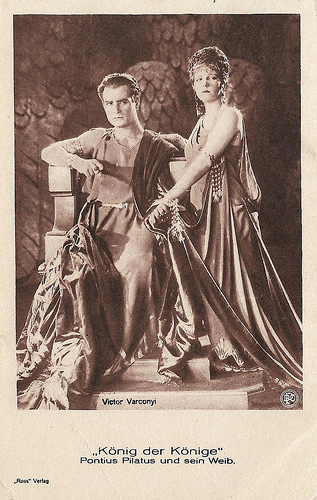
German postcard by Ross Verlag, unnumbered. Photo: DPG (Deutsche Photographische Gesellschaft). Postcard for the American silent epic The King of Kings (Cecil B. DeMille, 1927). Caption: Pontius Pilate and his wife. Pilate was played by Victor Varconi , his wife Proculla by Majel Coleman.
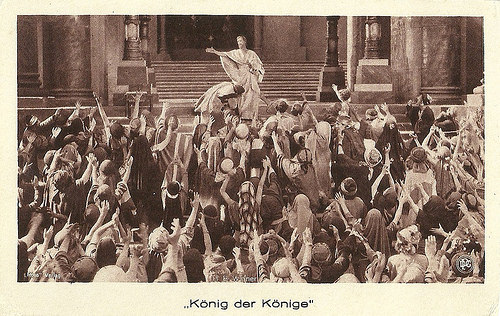
German postcard by Ross Verlag, unnumbered. Photo: DPG (Deutsche Photographische Gesellschaft). Postcard for the American silent epic The King of Kings (Cecil B. DeMille, 1927) with H.B. Warner as Jesus.
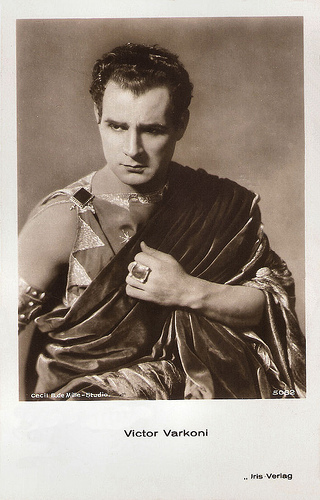
Austrian postcard by Iris Verlag, no. 5062. Photo: Cecil B. de Mille-Studio. Publicity still for The King of Kings (Cecil B. DeMille, 1927). Victor Varconi as Pontus Pilate.
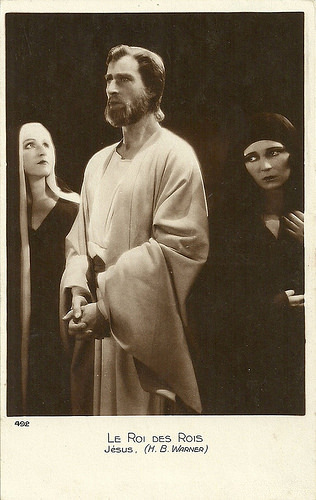
French postcard, no. 492. Postcard for the American silent epic The King of Kings (Cecil B. DeMille, 1927). Jesus (H.B. Warner) between the Virgin Mary (Dorothy Cumming) and Mary Magdalene (Jacqueline Logan).
Sources: David Fahey and Linda Rich (Masters of Starlight), Hal Erickson (AllMovie), Wikipedia and IMDb.

German postcard by Ross Verlag, no. 86/1. Photo: National Film. Dorothy Cumming as the Virgin Mary in Cecil B. deMille's The King of Kings (1927). Caption: Mary and the blind girl.

German postcard by Ross Verlag, no. 86/3. Photo: National Film. Postcard for the American silent epic The King of Kings (Cecil B. DeMille, 1927). Caption: Mary Magdalene. The charioteer was played by Noble Johnson, while Jacqueline Logan played Mary Magdalene.

German postcard by Ross Verlag, no. 86/3. Photo: National Film. Postcard for the American silent epic The King of Kings (Cecil B. DeMille, 1927). Caption: Jesus (H.B. Warner) resurrects Lazarus from the Dead.

German postcard by Ross Verlag, no. 86/4. Photo: National Film. Postcard for the American silent epic The King of Kings (Cecil B. DeMille, 1927). Caption: Mary Magdalene (Jacqueline Logan) dries Jesus' feet.

German postcard by Ross Verlag, no. 86/5. Photo: National-Film. Postcard for the American silent epic The King of Kings (Cecil B. DeMille, 1927). Caption: Caiaphas the High Priest of Israel (Rudolph Schildkraut).

German postcard by Ross Verlag, no. 86/6. Photo: National-Film. Publicity still for King of Kings (Cecil B. De Mille, 1927). Caption: Caiphas accuses Jesus before Pontius Pilate. Victor Varconi as Pontius Pilate the Governor of Judea, H.B. Warner as Jesus and Rudolph Schildkraut as Caiaphas.

German postcard by Ross Verlag, no. 86/8. Photo: National-Film. Postcard for the American silent epic The King of Kings (Cecil B. DeMille, 1927). Caption: The Last Supper.

German postcard by Ross Verlag, no. 86/9. Photo: National-Film. Postcard for the American silent epic The King of Kings (Cecil B. DeMille, 1927). Caption: Jesus (H.B. Warner) and his Mother (Dorothy Cumming).
Equal amounts of showmanship and reverence
Hal Erickson at AllMovie : "Having scored big-time box office with his first Biblical epic, The Ten Commandments (1923), Cecil B. DeMille hoped to top this success with his 1927 The King of Kings.
Inasmuch as he was now dealing with the life of Christ, DeMille had to be careful to serve up equal amounts of showmanship and reverence.
The first creative challenge: how to "introduce" Christ in a tasteful manner? The answer: as a blind child is cured through Jesus' intervention, DeMille cuts to the child's point-of-view, slowly fading in on the kindly countenance of H.B. Warner as the Son of Man.
Still, DeMille remained DeMille, especially in his handling of the character of Mary Magdalene (Jacqueline Logan). No longer a tattered streetwalker, Mary Magdalene is now a glamorous courtesan, replete with legions of gorgeous slave girls."
"Once he's gotten his box-office considerations out of the way, DeMille adheres faithfully to the particulars of Jesus' life, betrayal, trial, Crucifixion, and Resurrection. (Again, however, the director improves a bit upon his source material: the storm that follows the Crucifixion is of the same spectacular dimensions as the parting of the Red Sea in Ten Commandments, while the Resurrection is filmed in vibrant Technicolor).
To back up the authenticity of his images, DeMille -- with an assist from scenarist Jeannie Macpherson -- utilizes Scriptural quotes in his subtitles."
The King of Kings is the first film for which the still were made by a hand-held camera. Photographer William Mortenson made four hundred negatives that capture scenes as they were being shot, not posed afterwards.

German postcard by Ross Verlag, no. 86/10. Photo: National-Film. Postcard for the American silent epic The King of Kings (Cecil B. DeMille, 1927). Caption: Jesus (H.B. Warner) and the Captain of the Temple Guards (Theodore Kosloff).

German postcard by Ross Verlag, no. 86/11. Photo: National Film. Postcard for the American silent epic The King of Kings (Cecil B. DeMille, 1927). Caption: Jesus (H.B. Warner) on the way to Golgotha. The man helping to carry the cross could be William Boyd, who played Simon of Cyrene.

German postcard by Ross Verlag, no. 86/12. Photo: National Film. Postcard for the American silent epic The King of Kings (Cecil B. DeMille, 1927). Caption: Under the Cross.

German postcard by Ross Verlag, unnumbered. Photo: DPG (Deutsche Photographische Gesellschaft). Postcard for the American silent epic The King of Kings (Cecil B. DeMille, 1927). Caption: Pontius Pilate and his wife. Pilate was played by Victor Varconi , his wife Proculla by Majel Coleman.

German postcard by Ross Verlag, unnumbered. Photo: DPG (Deutsche Photographische Gesellschaft). Postcard for the American silent epic The King of Kings (Cecil B. DeMille, 1927) with H.B. Warner as Jesus.

Austrian postcard by Iris Verlag, no. 5062. Photo: Cecil B. de Mille-Studio. Publicity still for The King of Kings (Cecil B. DeMille, 1927). Victor Varconi as Pontus Pilate.

French postcard, no. 492. Postcard for the American silent epic The King of Kings (Cecil B. DeMille, 1927). Jesus (H.B. Warner) between the Virgin Mary (Dorothy Cumming) and Mary Magdalene (Jacqueline Logan).
Sources: David Fahey and Linda Rich (Masters of Starlight), Hal Erickson (AllMovie), Wikipedia and IMDb.
Published on November 14, 2018 22:00
November 13, 2018
Wheeler & Woolsey
Wheeler & Woolsey were an American comedy double act. They performed together in slapstick comedy films for RKO from the late 1920s until Robert Woolsey's death in 1938. Curly-haired Bert Wheeler (1895–1968) played an ever-smiling innocent, who was easily led and not very bright, but who would also sometimes display a stubborn streak of conscience. Bespectacled Robert 'Bob' Woolsey (1888–1938) played a genially leering, cigar-smoking, fast-talking idea man who often got the pair in trouble. Wheeler & Woolsey made 21 films together, a series that often pushed the boundaries of taste and logic.

British postcard in the Filmshots series by Film Weekly. Photo: Radio. Publicity still for So This Is Africa (Edward F. Cline, 1933). The Columbia Pictures release So This Is Africa was made during a contract dispute of Wheeler and Woolsey with RKO.
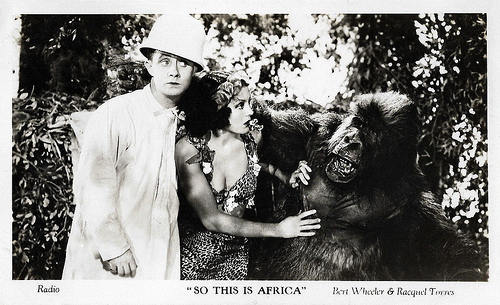
British postcard in the Filmshots series by Film Weekly. Photo: Radio. Publicity still for So This Is Africa (Edward F. Cline, 1933) with Bert Wheeler and Raquel Torres.
Bert Wheeler
Albert Jerome Wheeler was born in 1895 in Paterson, New Jersey, USA. His mother died at the age of 17, when Bert was a baby. After becoming an orphan, he was raised by his father and aunt, and later by a step-mother.
Wheeler went to New York, where he tried to break into showbiz. He got his first break with Gus Edwards. Later, he worked as an actor in several shows, including The Gingerbread Man and When Dreams Come True.
During When Dreams Come True, he met his first wife, Margaret Grae, with whom he formed up a successful vaudeville team. Although being asked several times to make films, Wheeler stayed with vaudeville. In 1926 the couple divorced and Grae soon married another actor.
In 1927 Wheeler was signed by Florenz Ziegfeld Jr. for his show Rio Rita, where he was teamed with Robert Woolsey. They clicked and when Ziegfeld sold the screen rights of Rio Rita to the newly formed RKO studio as their official debut, they were the only actors in the cast who repeated their stage roles in the film version.
Rio Rita (Luther Reed, 1929) starring Bebe Daniels, was a success and this convinced them to become a permanent team. From 1930 until 1937, they made a series of 20 very popular comedy feature films, all for RKO Radio Pictures - with the exception of the Columbia production So This Is Africa (Edward F. Cline, 1933).
Bob Woolsey was often the huckster, his big cigar and waggling eyebrows wafting him into the direction of a gigantic but adoring woman. Bert Wheeler was a bit more conventional, but specialised in a special line of willful innocence that sometimes went to extremes; his specialty was singing and eating at the same time.
David Boxwell in the film journal Bright Lights : "Exhaustively citing all the sexual innuendo in Wheeler and Woolsey’s best films would be virtually impossible, but here are a few choice examples. In Diplomaniacs, the sexually aggressive Fifi tries to assassinate Woolsey’s character by kissing him to death, but he survives and causes the vamp to drop to the ground, her body smoking. Wheeler asks him: “Hey, where’s your cigar?” Woolsey confidently claims: “She swallowed it.” Sometimes a cigar is just a cigar, but never in a Wheeler and Woolsey film."
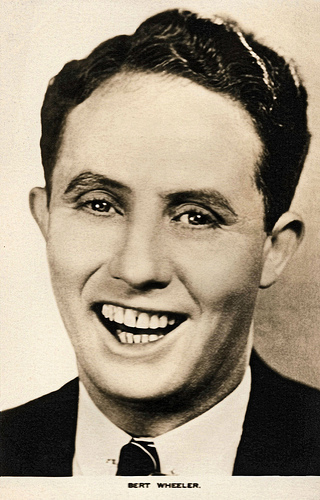
Bert Wheeler. British postcard in the Film Weekly series, London.
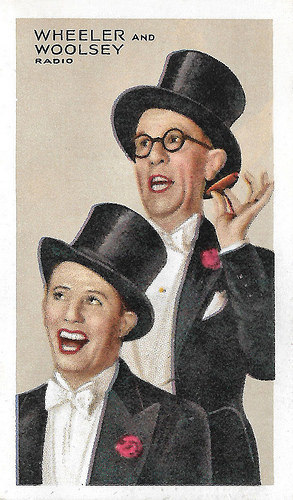
British cigarette card in the Stars of Screen & Stage series by Park Drive Cigarettes, Gallaher Ltd., London & Belfast, no. 6. Photo: Radio. Collection: Geoffrey Donaldson Institute.
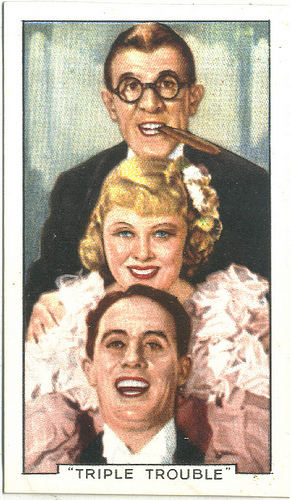
British cigarette card in the Famous Film Scenes series by Park Drive Cigarettes, Gallaher Ltd., London & Belfast, no. 24. Photo: Radio. Publicity still for Triple Trouble/Kentucky Kernels (George Stevens, 1934) with Mary Carlisle. Collection: Manuel Palomino Arjona @ Flickr.
Robert Woolsey
Robert Rolla Woolsey was born in 1888 in Oakland, California, USA. At the age of 7, his father died, leaving his mother and their six children in poverty. Four of the children died in their early years. To earn some money to support the family, Bob took odd jobs, before becoming a jockey. This career ended when the horse, Pink Star, the future Kentucky Derby winner of 1907, fell and broke Bob's leg.
Woolsey then went to work as a bellboy at the Hotel Sinton in Cincinnati, Ohio, where he came in contact with actors who saw possibilities for him as a comic in the theatre. He joined several vaudeville companies, and toured not only North America, but also the British Empire. In 1917, he married an eccentric dancer, Mignone Park Reed. The couple stayed together till his death.
In 1922, Woolsey appeared with W.C. Fields in The Blue Kitten, and he also wrote some plays. He hit it big, when he was signed for Florenz Ziegfeld Jr.'s Rio Rita in 1927, where he teamed up with Bert Wheeler. Due to their success, they were teamed up again in The Cuckoos (Paul Sloane, 1930), based on the Broadway show The Ramblers. It was another box office hit. Double-entendre gags were a hallmark of their comedies, although they were severely curtailed after the reconstitution of the Production Code in 1934. Dressing in drag and other forms of gender inversion were also staples of their films.
David Boxwell in Bright Lights : "Wheeler and Woolsey didn’t invent drag, but more than any other early sound comedy stars they cross-dressed with complete aplomb, and to hilarious effect. Wheeler often, but not always, plays femme to Woolsey’s butch, so he’s in drag more than the guy with the cigar, but Woolsey is dressed as a 'native girl' in a fetching leopard skin two-piece at the end of So This Is Africa — as he is abducted by a beefy “Tarzan” and taken into a hut for what will be a bout of unseen sex."
By 1931, Wheeler & Woolsey were so popular that RKO attempted to generate twice the Wheeler & Woolsey income by making two solo pictures - Too Many Crooks (William A. Seiter, 1931) with Wheeler, and Everything's Rosie (Clyde Bruckman, 1931) with Woolsey. This experiment failed, and they returned to films as a team. Among the pair's following features are Caught Plastered (William A. Seiter, 1931), Peach O'Reno (William A. Seiter, 1931), and Diplomaniacs (William A. Seiter, 1933).
Mark Sandrich directed them in Hips Hips Hooray (1934) and Cockeyed Cavaliers (1934), both co-starring Thelma Todd and Dorothy Lee. After Sandrich was promoted to the Fred Astaire-Ginger Rogers musicals, he was replaced by George Stevens. Stevens directed them in Kentucky Kernels (1934) with Mary Carlisle, and The Nitwits (1935) with Betty Grable. After Stevens left the series, the quality of Wheeler & Woolsey's output dwindled. In some of these later films, Wheeler and Woolsey didn't even appear as a team, but as strangers who encounter each other by chance.
Robert Woolsey's health deteriorated in 1936, and after struggling to complete High Flyers (Edward Cline, 1937) with Lupe Velez, he was no longer able to work. Bob Woolsey died on 31 October 1938 of kidney disease. After his death, Bert Wheeler continued to work off and on through the 1960s, mostly on the stage, but sometimes also on television. In later years he formed a team with a new, young partner, Tommy Dillon, with whom he worked in Las Vegas and Manhattan's Latin Quarter.
Bert Wheeler's last years were darkened with financial difficulties and failing health. Furthermore, two weeks before his own death in 1968 his only daughter Patricia Anne Wheeler died of cancer. Wheeler was 72. He married five times: to Margaret Grae (1915-1926), Bernice Wheeler (1928-1936), Sally Haines (1937-1939), Patsy Orr (1952-1956) and Olga Desmondae 'Des' Rieman (1961-1966 - her death).
Despite their great popularity in the 1930s, Wheeler & Woolsey are little known today. IMDb : "One of the reasons likely is the fact that their films were not packaged and sold to television in the 1950s, unlike The Three Stooges and Laurel & Hardy , who then went on to entertain new generations of fans. (...) Their shorts were geared towards adults, and even in the 1930s, they were considered vulgar, and thus would have been inappropriate on television in the 1950s as the comedy shorts of the Stooges and Laurel & Hardy were programmed for children."
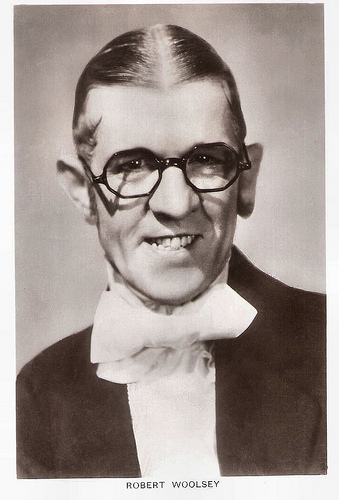
Robert Woolsey. British postcard in the Picturegoer Series, London, no. 514.
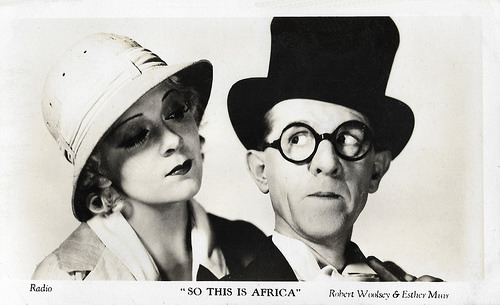
British postcard in the Filmshots series by Film Weekly. Photo: Radio. Publicity still for So This Is Africa (Edward F. Cline, 1933) with Esther Muir and Robert Woolsey.
Sources: David Boxwell (Bright Lights film journal), (IMDb), Pre-code.com, Wikipedia and .

British postcard in the Filmshots series by Film Weekly. Photo: Radio. Publicity still for So This Is Africa (Edward F. Cline, 1933). The Columbia Pictures release So This Is Africa was made during a contract dispute of Wheeler and Woolsey with RKO.

British postcard in the Filmshots series by Film Weekly. Photo: Radio. Publicity still for So This Is Africa (Edward F. Cline, 1933) with Bert Wheeler and Raquel Torres.
Bert Wheeler
Albert Jerome Wheeler was born in 1895 in Paterson, New Jersey, USA. His mother died at the age of 17, when Bert was a baby. After becoming an orphan, he was raised by his father and aunt, and later by a step-mother.
Wheeler went to New York, where he tried to break into showbiz. He got his first break with Gus Edwards. Later, he worked as an actor in several shows, including The Gingerbread Man and When Dreams Come True.
During When Dreams Come True, he met his first wife, Margaret Grae, with whom he formed up a successful vaudeville team. Although being asked several times to make films, Wheeler stayed with vaudeville. In 1926 the couple divorced and Grae soon married another actor.
In 1927 Wheeler was signed by Florenz Ziegfeld Jr. for his show Rio Rita, where he was teamed with Robert Woolsey. They clicked and when Ziegfeld sold the screen rights of Rio Rita to the newly formed RKO studio as their official debut, they were the only actors in the cast who repeated their stage roles in the film version.
Rio Rita (Luther Reed, 1929) starring Bebe Daniels, was a success and this convinced them to become a permanent team. From 1930 until 1937, they made a series of 20 very popular comedy feature films, all for RKO Radio Pictures - with the exception of the Columbia production So This Is Africa (Edward F. Cline, 1933).
Bob Woolsey was often the huckster, his big cigar and waggling eyebrows wafting him into the direction of a gigantic but adoring woman. Bert Wheeler was a bit more conventional, but specialised in a special line of willful innocence that sometimes went to extremes; his specialty was singing and eating at the same time.
David Boxwell in the film journal Bright Lights : "Exhaustively citing all the sexual innuendo in Wheeler and Woolsey’s best films would be virtually impossible, but here are a few choice examples. In Diplomaniacs, the sexually aggressive Fifi tries to assassinate Woolsey’s character by kissing him to death, but he survives and causes the vamp to drop to the ground, her body smoking. Wheeler asks him: “Hey, where’s your cigar?” Woolsey confidently claims: “She swallowed it.” Sometimes a cigar is just a cigar, but never in a Wheeler and Woolsey film."

Bert Wheeler. British postcard in the Film Weekly series, London.

British cigarette card in the Stars of Screen & Stage series by Park Drive Cigarettes, Gallaher Ltd., London & Belfast, no. 6. Photo: Radio. Collection: Geoffrey Donaldson Institute.

British cigarette card in the Famous Film Scenes series by Park Drive Cigarettes, Gallaher Ltd., London & Belfast, no. 24. Photo: Radio. Publicity still for Triple Trouble/Kentucky Kernels (George Stevens, 1934) with Mary Carlisle. Collection: Manuel Palomino Arjona @ Flickr.
Robert Woolsey
Robert Rolla Woolsey was born in 1888 in Oakland, California, USA. At the age of 7, his father died, leaving his mother and their six children in poverty. Four of the children died in their early years. To earn some money to support the family, Bob took odd jobs, before becoming a jockey. This career ended when the horse, Pink Star, the future Kentucky Derby winner of 1907, fell and broke Bob's leg.
Woolsey then went to work as a bellboy at the Hotel Sinton in Cincinnati, Ohio, where he came in contact with actors who saw possibilities for him as a comic in the theatre. He joined several vaudeville companies, and toured not only North America, but also the British Empire. In 1917, he married an eccentric dancer, Mignone Park Reed. The couple stayed together till his death.
In 1922, Woolsey appeared with W.C. Fields in The Blue Kitten, and he also wrote some plays. He hit it big, when he was signed for Florenz Ziegfeld Jr.'s Rio Rita in 1927, where he teamed up with Bert Wheeler. Due to their success, they were teamed up again in The Cuckoos (Paul Sloane, 1930), based on the Broadway show The Ramblers. It was another box office hit. Double-entendre gags were a hallmark of their comedies, although they were severely curtailed after the reconstitution of the Production Code in 1934. Dressing in drag and other forms of gender inversion were also staples of their films.
David Boxwell in Bright Lights : "Wheeler and Woolsey didn’t invent drag, but more than any other early sound comedy stars they cross-dressed with complete aplomb, and to hilarious effect. Wheeler often, but not always, plays femme to Woolsey’s butch, so he’s in drag more than the guy with the cigar, but Woolsey is dressed as a 'native girl' in a fetching leopard skin two-piece at the end of So This Is Africa — as he is abducted by a beefy “Tarzan” and taken into a hut for what will be a bout of unseen sex."
By 1931, Wheeler & Woolsey were so popular that RKO attempted to generate twice the Wheeler & Woolsey income by making two solo pictures - Too Many Crooks (William A. Seiter, 1931) with Wheeler, and Everything's Rosie (Clyde Bruckman, 1931) with Woolsey. This experiment failed, and they returned to films as a team. Among the pair's following features are Caught Plastered (William A. Seiter, 1931), Peach O'Reno (William A. Seiter, 1931), and Diplomaniacs (William A. Seiter, 1933).
Mark Sandrich directed them in Hips Hips Hooray (1934) and Cockeyed Cavaliers (1934), both co-starring Thelma Todd and Dorothy Lee. After Sandrich was promoted to the Fred Astaire-Ginger Rogers musicals, he was replaced by George Stevens. Stevens directed them in Kentucky Kernels (1934) with Mary Carlisle, and The Nitwits (1935) with Betty Grable. After Stevens left the series, the quality of Wheeler & Woolsey's output dwindled. In some of these later films, Wheeler and Woolsey didn't even appear as a team, but as strangers who encounter each other by chance.
Robert Woolsey's health deteriorated in 1936, and after struggling to complete High Flyers (Edward Cline, 1937) with Lupe Velez, he was no longer able to work. Bob Woolsey died on 31 October 1938 of kidney disease. After his death, Bert Wheeler continued to work off and on through the 1960s, mostly on the stage, but sometimes also on television. In later years he formed a team with a new, young partner, Tommy Dillon, with whom he worked in Las Vegas and Manhattan's Latin Quarter.
Bert Wheeler's last years were darkened with financial difficulties and failing health. Furthermore, two weeks before his own death in 1968 his only daughter Patricia Anne Wheeler died of cancer. Wheeler was 72. He married five times: to Margaret Grae (1915-1926), Bernice Wheeler (1928-1936), Sally Haines (1937-1939), Patsy Orr (1952-1956) and Olga Desmondae 'Des' Rieman (1961-1966 - her death).
Despite their great popularity in the 1930s, Wheeler & Woolsey are little known today. IMDb : "One of the reasons likely is the fact that their films were not packaged and sold to television in the 1950s, unlike The Three Stooges and Laurel & Hardy , who then went on to entertain new generations of fans. (...) Their shorts were geared towards adults, and even in the 1930s, they were considered vulgar, and thus would have been inappropriate on television in the 1950s as the comedy shorts of the Stooges and Laurel & Hardy were programmed for children."

Robert Woolsey. British postcard in the Picturegoer Series, London, no. 514.

British postcard in the Filmshots series by Film Weekly. Photo: Radio. Publicity still for So This Is Africa (Edward F. Cline, 1933) with Esther Muir and Robert Woolsey.
Sources: David Boxwell (Bright Lights film journal), (IMDb), Pre-code.com, Wikipedia and .
Published on November 13, 2018 22:00
November 12, 2018
Clint Walker
Heavy set, athletic Clint Walker (1927- 2018) was an American actor and singer. In the 1950s, Walker with his broad shoulders and slim waist almost single-handedly started the Western craze on TV in his role as Cheyenne Bodie in Cheyenne (1955-1962).
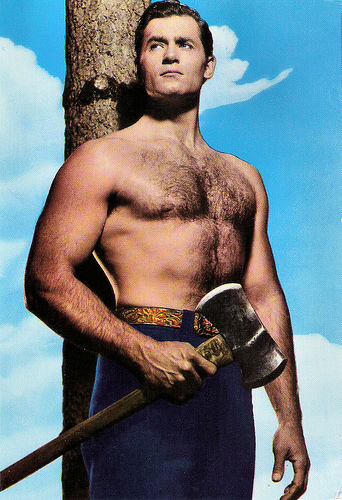
Spanish postcard by Raker, no. 1155, 1965. Photo: publicity still for Cheyenne (1955-1962).
Good looks and imposing physique
Clint Walker was born Norman Eugene Walker in 1927 in Hartford, Illinois. He was the son of Gladys Huldah (née Schwanda) and Paul Arnold Walker. He had a twin sister named Lucy.
At 16, Walker left high school to work at a factory and on a river boat, then joined the United States Merchant Marine at the age of 17 in the last months of World War II. After the war he worked his way cross country, including working in the oil fields in Brownwood, Texas, and wound up in California, where he worked as an undercover agent for a private detective agency on the Long Beach waterfront. After a while he took a job as a security officer at the Sands Hotel in Las Vegas.
It was there that he met quite a few Hollywood people who told him that his size, physique and good looks would serve him well in Hollywood and that he should go to Los Angeles and give it a try. Walker became a client of Henry Willson, who renamed him Jett Norman and cast him to appear in the Bowery Boys film Jungle Gents (Edward Bernds, 1955) as a Tarzan-type character.
He was then hired by Cecil B. DeMille to appear in The Ten Commandments (1956). Someone from Warner Bros. saw the film, found out that Walker was under contract to producer Hal B. Wallis, and auditioned him for a new Western TV series.
Clint Walker's good looks and imposing physique helped him win the lead role in the TV series Cheyenne (1955). He was cast as Cheyenne Bodie, a roaming cowboy hero in the post-American Civil War era. Cheyenne originally appeared as part of Warner Bros Presents rotating with adaptations of Kings Row and Casablanca.
Cheyenne turned out to be the break out hit for Walker. While the series regularly capitalised on Walker's rugged frame with frequent bare-chested scenes, it was also well written and acted. It proved hugely popular for eight seasons. Walker's pleasant baritone singing voice was also occasionally utilised on the series and led Warner Brothers to produce an album of Walker doing traditional songs and ballads.
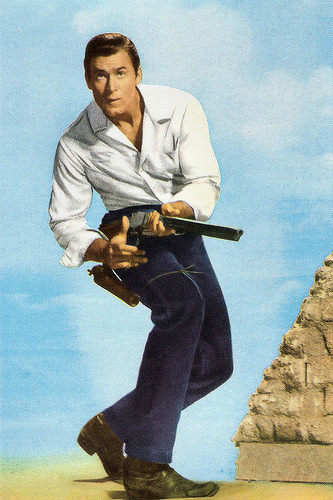
Spanish postcard by Raker, no. 1111. Photo: publicity still for the TV series Cheyenne (1955-1962).
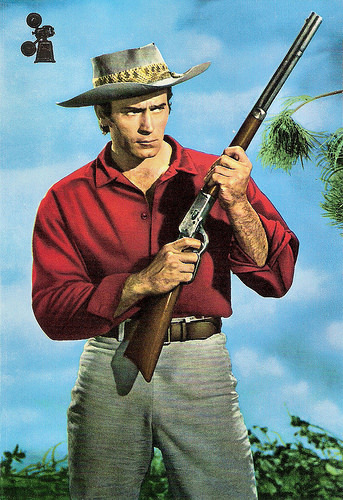
Spanish postcard by Toro de Bronce, no. 77. Photo: Warner Bros. Publicity still for Yellowstone Kelly (Gordon Douglas, 1959).
The Dirty Dozen
Warner also cast Clint Walker in the lead of a Western feature film, Fort Dobbs (Gordon Douglas, 1958), but box office returns were modest. Warner tried him in another Douglas-directed Western, Yellowstone Kelly (Gordon Douglas, 1959), co-starring Ed Byrnes from another Warner TV show, 77 Sunset Strip. It was a minor success.
A number of Cheyenne episodes were cut into feature films and released theatrically in some markets and Walker guest-starred as Bodie in an episode of the TV show Maverick. Warner tried Walker in a third Western feature directed by Douglas, Gold of the Seven Saints (Gordon Dougals, 1961), this time co-starring Roger Moore , who was also under contract to Warner. Cheyenne ended in 1962.
Post-Cheyenne, Clint Walker had a supporting part in the Rock Hudson-Doris Day comedy, Send Me No Flowers (Norman Jewison, 1964). Frank Sinatra cast him in the war time drama None but the Brave (1965), the only film Sinatra directed. After doing some guest appearances in The Lucy Show he fought a grizzly bear in Paramount's Western, The Night of the Grizzly (Joseph Pevney, 1966) with Martha Hyer . He starred in a family adventure movie shot in India, Maya (John Berry, 1966).
Walker had his biggest hit to date when the played the meek convict Samson Posey in the war drama The Dirty Dozen (Robert Aldrich, 1967), starring Lee Marvin. Walker returned to Westerns with More Dead Than Alive (Robert Sparr, 1969) with Vincent Price, and had supporting roles in two comic Westerns, Sam Whiskey (Arnold Laven, 1969) and The Great Bank Robbery (Hy Averback, 1969). Walker was one of many names in The Phynx (Lee H. Katzin, 1970).
In May 1971, he was involved in a freak accident at Mammoth Mountain, CA, when the tip of a ski pole pierced his heart. He made an amazing recovery and was back at work filming in Spain two months later. He supported Telly Savalas there in the British-Spanish-American biopic Pancho Villa (Robert Sparr, 1972) and starred in the short-lived TV series Kodiak (1974), playing an Alaskan patrolman. He also starred in the made-for-television cult film Killdozer! (Jerry London, 1974).
His later films included The White Buffalo (J. Lee Thompson, 1977) starring Charles Bronson, Deadly Harvest (Timothy Bond, 1977) and Mysterious Island of Beautiful Women (Joseph Pevney, 1979). His later roles were mostly minor, but in 1998, he voiced Nick Nitro in the animation film Small Soldiers (Joe Dante, 1998).
Then he retired. Clint Walker was married to Verna Garver (1948-1968), Giselle Hennesy (1974-1994) and Susan Cavallari (1997-now). He has one daughter Valerie (1950) with Verna Garver.
Clint Walker died of congestive heart failure in Grass Valley, California, on 21 May 2018, nine days before his 91st birthday.
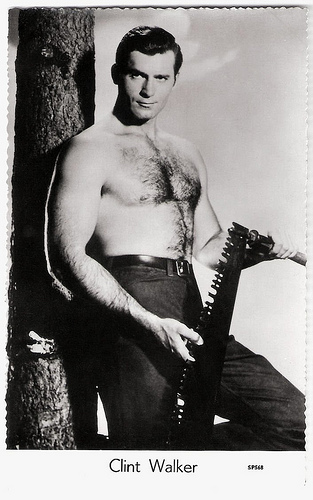
Vintage postcard, no. SP568.
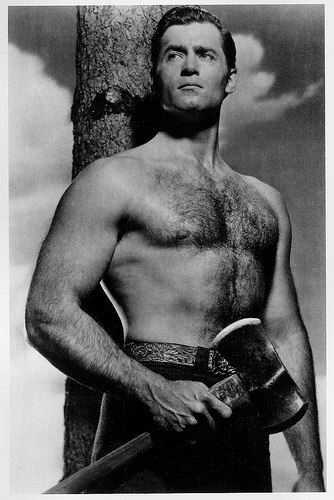
American postcard by The American Postcard Co. Inc., no. 767, 1983. Photo: publicity still for Cheyenne (1955-1962).
Sources: Wikipedia and .

Spanish postcard by Raker, no. 1155, 1965. Photo: publicity still for Cheyenne (1955-1962).
Good looks and imposing physique
Clint Walker was born Norman Eugene Walker in 1927 in Hartford, Illinois. He was the son of Gladys Huldah (née Schwanda) and Paul Arnold Walker. He had a twin sister named Lucy.
At 16, Walker left high school to work at a factory and on a river boat, then joined the United States Merchant Marine at the age of 17 in the last months of World War II. After the war he worked his way cross country, including working in the oil fields in Brownwood, Texas, and wound up in California, where he worked as an undercover agent for a private detective agency on the Long Beach waterfront. After a while he took a job as a security officer at the Sands Hotel in Las Vegas.
It was there that he met quite a few Hollywood people who told him that his size, physique and good looks would serve him well in Hollywood and that he should go to Los Angeles and give it a try. Walker became a client of Henry Willson, who renamed him Jett Norman and cast him to appear in the Bowery Boys film Jungle Gents (Edward Bernds, 1955) as a Tarzan-type character.
He was then hired by Cecil B. DeMille to appear in The Ten Commandments (1956). Someone from Warner Bros. saw the film, found out that Walker was under contract to producer Hal B. Wallis, and auditioned him for a new Western TV series.
Clint Walker's good looks and imposing physique helped him win the lead role in the TV series Cheyenne (1955). He was cast as Cheyenne Bodie, a roaming cowboy hero in the post-American Civil War era. Cheyenne originally appeared as part of Warner Bros Presents rotating with adaptations of Kings Row and Casablanca.
Cheyenne turned out to be the break out hit for Walker. While the series regularly capitalised on Walker's rugged frame with frequent bare-chested scenes, it was also well written and acted. It proved hugely popular for eight seasons. Walker's pleasant baritone singing voice was also occasionally utilised on the series and led Warner Brothers to produce an album of Walker doing traditional songs and ballads.

Spanish postcard by Raker, no. 1111. Photo: publicity still for the TV series Cheyenne (1955-1962).

Spanish postcard by Toro de Bronce, no. 77. Photo: Warner Bros. Publicity still for Yellowstone Kelly (Gordon Douglas, 1959).
The Dirty Dozen
Warner also cast Clint Walker in the lead of a Western feature film, Fort Dobbs (Gordon Douglas, 1958), but box office returns were modest. Warner tried him in another Douglas-directed Western, Yellowstone Kelly (Gordon Douglas, 1959), co-starring Ed Byrnes from another Warner TV show, 77 Sunset Strip. It was a minor success.
A number of Cheyenne episodes were cut into feature films and released theatrically in some markets and Walker guest-starred as Bodie in an episode of the TV show Maverick. Warner tried Walker in a third Western feature directed by Douglas, Gold of the Seven Saints (Gordon Dougals, 1961), this time co-starring Roger Moore , who was also under contract to Warner. Cheyenne ended in 1962.
Post-Cheyenne, Clint Walker had a supporting part in the Rock Hudson-Doris Day comedy, Send Me No Flowers (Norman Jewison, 1964). Frank Sinatra cast him in the war time drama None but the Brave (1965), the only film Sinatra directed. After doing some guest appearances in The Lucy Show he fought a grizzly bear in Paramount's Western, The Night of the Grizzly (Joseph Pevney, 1966) with Martha Hyer . He starred in a family adventure movie shot in India, Maya (John Berry, 1966).
Walker had his biggest hit to date when the played the meek convict Samson Posey in the war drama The Dirty Dozen (Robert Aldrich, 1967), starring Lee Marvin. Walker returned to Westerns with More Dead Than Alive (Robert Sparr, 1969) with Vincent Price, and had supporting roles in two comic Westerns, Sam Whiskey (Arnold Laven, 1969) and The Great Bank Robbery (Hy Averback, 1969). Walker was one of many names in The Phynx (Lee H. Katzin, 1970).
In May 1971, he was involved in a freak accident at Mammoth Mountain, CA, when the tip of a ski pole pierced his heart. He made an amazing recovery and was back at work filming in Spain two months later. He supported Telly Savalas there in the British-Spanish-American biopic Pancho Villa (Robert Sparr, 1972) and starred in the short-lived TV series Kodiak (1974), playing an Alaskan patrolman. He also starred in the made-for-television cult film Killdozer! (Jerry London, 1974).
His later films included The White Buffalo (J. Lee Thompson, 1977) starring Charles Bronson, Deadly Harvest (Timothy Bond, 1977) and Mysterious Island of Beautiful Women (Joseph Pevney, 1979). His later roles were mostly minor, but in 1998, he voiced Nick Nitro in the animation film Small Soldiers (Joe Dante, 1998).
Then he retired. Clint Walker was married to Verna Garver (1948-1968), Giselle Hennesy (1974-1994) and Susan Cavallari (1997-now). He has one daughter Valerie (1950) with Verna Garver.
Clint Walker died of congestive heart failure in Grass Valley, California, on 21 May 2018, nine days before his 91st birthday.

Vintage postcard, no. SP568.

American postcard by The American Postcard Co. Inc., no. 767, 1983. Photo: publicity still for Cheyenne (1955-1962).
Sources: Wikipedia and .
Published on November 12, 2018 22:00
November 11, 2018
Mary Miles Minter
Young Mary Miles Minter (1902-1984) was an American silent screen actress. Between 1912 to 1923, she appeared in over 50 silent films. The popular, innocent looking Miles Minter was the main rival of Mary Pickford. In 1922, she was involved in the major scandal surrounding the murder of director William Desmond Taylor. Her reputation was tarnished, and she gave up her film career at the age of 21.
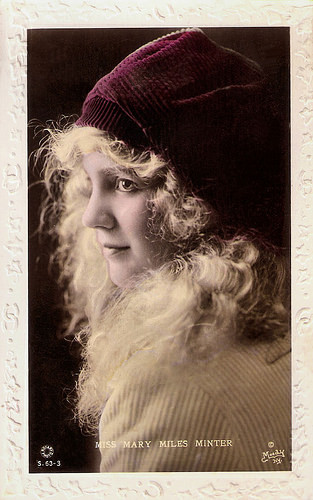
British postcard by Rotary Photo, London, no. S. 63-3. Photo: Moody, N.Y.
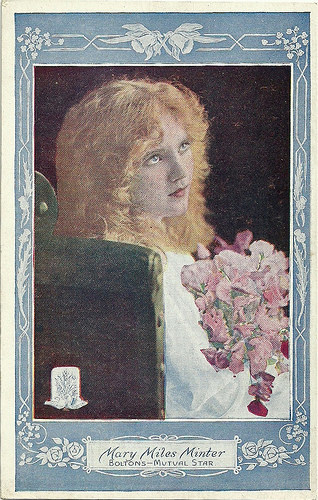
British postcard by John Horn, London/Glasgow. Photo: Boltons-Mutual.
The Rival of Mary Pickford
Mary Miles Minter was born as Juliet Reilly in 1902 in Shreveport as the daughter of Jason Homer Reilly and Broadway actress Charlotte Shelby. Shelby wanted that Juliet and her older sister Margaret also became stage actresses. Margaret became known as the actress Margaret Shelby.
One night when there was no babysitter available, the 5-year-old Juliet accompanied her sister to an audition, was discovered. She got her first stage role in the play Cameo Kirby. She soon became noted for both her talent and visual appeal. Her greatest stage success was in The Littlest Rebel, with William Farnum and Dustin Farnum.
She made her cinema debut in the short film The Nurse (Pat Powers, 1912) credited as Juliet Shelby. In order to avoid the Child Labor Act, she took the name 'Mary Miles Minter' from an aunt who, along with her daughter, had died after unknowingly consuming apple cider contaminated with snake's venom. The aunt's daughter's birth certificate was passed off as Minter's own, allowing the ten-year-old to masquerade as a 17-year-old.
Under her new stage name, she got her first substantial lead in a feature film, The Fairy and the Waif (Marie Hubert Frohmann, George Irving, 1915). She played Viola Drayton, the fairy.
Minter's career steadily grew after that. She specialised in playing demure young women. She started to work for Metro Pictures, and in 1916 she moved on to Mutual Pictures. Minter always played the leads in her films, despite her young age. Her early pictures carried this theme with such titles as Lovely Mary (Edgar Jones, 1916), Faith (James Kirkwood, 1916) and Dimples (Edgar Jones, 1916).
With her innocent appearance, her photogenic features, blue eyes and curly blonde hair, Minter became popular and grew into a rival of Mary Pickford. In 1917 she moved to the American Film Company, where Henry King often directed her, and in 1918 she traded American for Paramount.
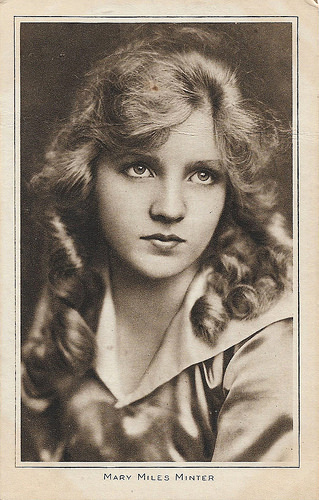
British postcard in the "Pictures" Portrait Gallery, London.
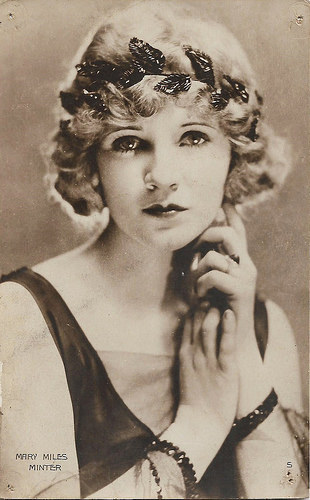
French postcard by Editions Cinémagazine, no. 5.
An unresolved Hollywood Murder
In 1919 Mary Miles Minter made her most famous film, the comedy-drama Anne of Green Gables with director William Desmond Taylor. It is considered lost now. The film became a huge success. Mary quickly fell in love with Taylor against her domineering mother's openly hostile objections. According to Miles Minter, a romantic relationship developed between the 16-year-old star and her 30-years-older director. But Taylor had reservations from the outset and later curtailed the romance, citing the age difference.
William Desmond Taylor started to promote his young actress, so that she would grow into a legendary star. Several films with Miles Minter in the lead were made by their newly founded production company Realart Pictures, but distributed by Paramount. Taylor initially directed her there, but after a few films various other directors stepped in, such as Paul Powell and Joseph Henabery. Her films included Judy of Rogue's Harbor (William Desmond Taylor, 1920), Jenny Be Good (William Desmond Taylor, 1920) and The Little Clown (Thomas N. Heffron, 1921). Her salary, which started at $150 per week in 1915, increased to $2250 per week.
In 1922 Taylor was murdered in his bungalow in the Westlake area of Los Angeles. The ensuing scandal was the subject of widespread media speculation. Newspapers reported that coded love letters written by Minter had been found in his bungalow after his death. She had written them three years earlier, in 1919. Minter was at the height of her success, having starred in more than 50 films, but the newspaper revelations of the 20-year-old star's association with the 49-year-old murdered director effectually killed her film career.
The murder case was the third major scandal to present itself in Hollywood. The first two were the drug-related suicide of beautiful young actress Olive Thomas in 1920 and the Roscoe 'Fatty' Arbuckle sex party outrage that ended in the death of actress wannabe Virginia Rappe.
In 1970, Miles Minter told in an interview that she collapsed when she saw the body of William Desmond Taylor in the morgue. In the long investigation of his murder, there were several suspects. Mary's mother Charlotte Shelby was long known as a suspect, but the perpetrator could not be found. In 1937, when the case was still unresolved, Minter demanded that she be given a prison sentence or that the case would be left alone.
After the death of Desmond Taylor, Minter made four more films for Paramount. Her last film was Trail of the Lonesome Pine (Charles Maigne, 1923) with Antonio Moreno and Ernest Torrence . The Trail of the Lonesome Pine is now considered lost.
After Mary's contract at Paramount was bought out for $350,000 in June of 1923, she was broached by other studios such as Ufa and Pathe with film offers, but the scandal took its toll on Mary and she emotionally wanted out of the public eye. She later said she was never happy in the times that she was an actress. In the late 1920s, Mary and her sister Margaret sued their mother Charlotte over mismanagement of their money and won substantial settlements. They eventually reconciled with their mother.
In 1957, Miles Minter married real estate developer Brandon O. Hildebrandt. They remained together until Hildebrandt's death in 1965. Minter told in interviews that she was much happier after her Hollywood years, although she was brutally beaten and robbed in her home in 1981. A former servant was charged with the crime. The 79-year-old Mary managed to recover.
In 1984, Miles Minter died of a stroke in Santa Monica, California, at the age of 82. All in all she had starred in some 53 films of which just a dozen survives. And in 1999 it was announced that one Ella Margaret Gibson admitted on her deathbed in 1964 that she had committed the murder of William Desmond Taylor. Not much later she died of a heart attack.
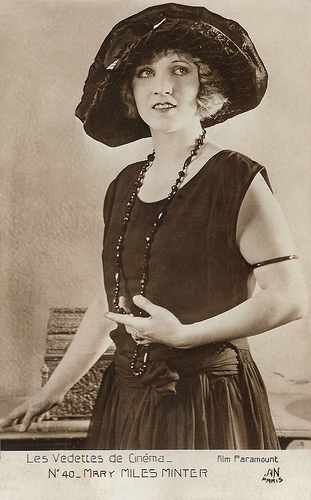
French postcard by A.N., Paris, in the Les Vedettes de Cinéma series, no. 40. Photo: Film Paramount.
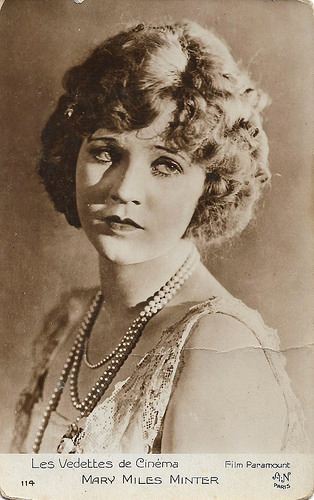
French postcard by A.N., Paris in the Les Vedettes de Cinéma series, no. 114. Photo: Film Paramount.
Sources: (IMDb), Wikipedia (English and Italian) and .

British postcard by Rotary Photo, London, no. S. 63-3. Photo: Moody, N.Y.

British postcard by John Horn, London/Glasgow. Photo: Boltons-Mutual.
The Rival of Mary Pickford
Mary Miles Minter was born as Juliet Reilly in 1902 in Shreveport as the daughter of Jason Homer Reilly and Broadway actress Charlotte Shelby. Shelby wanted that Juliet and her older sister Margaret also became stage actresses. Margaret became known as the actress Margaret Shelby.
One night when there was no babysitter available, the 5-year-old Juliet accompanied her sister to an audition, was discovered. She got her first stage role in the play Cameo Kirby. She soon became noted for both her talent and visual appeal. Her greatest stage success was in The Littlest Rebel, with William Farnum and Dustin Farnum.
She made her cinema debut in the short film The Nurse (Pat Powers, 1912) credited as Juliet Shelby. In order to avoid the Child Labor Act, she took the name 'Mary Miles Minter' from an aunt who, along with her daughter, had died after unknowingly consuming apple cider contaminated with snake's venom. The aunt's daughter's birth certificate was passed off as Minter's own, allowing the ten-year-old to masquerade as a 17-year-old.
Under her new stage name, she got her first substantial lead in a feature film, The Fairy and the Waif (Marie Hubert Frohmann, George Irving, 1915). She played Viola Drayton, the fairy.
Minter's career steadily grew after that. She specialised in playing demure young women. She started to work for Metro Pictures, and in 1916 she moved on to Mutual Pictures. Minter always played the leads in her films, despite her young age. Her early pictures carried this theme with such titles as Lovely Mary (Edgar Jones, 1916), Faith (James Kirkwood, 1916) and Dimples (Edgar Jones, 1916).
With her innocent appearance, her photogenic features, blue eyes and curly blonde hair, Minter became popular and grew into a rival of Mary Pickford. In 1917 she moved to the American Film Company, where Henry King often directed her, and in 1918 she traded American for Paramount.

British postcard in the "Pictures" Portrait Gallery, London.

French postcard by Editions Cinémagazine, no. 5.
An unresolved Hollywood Murder
In 1919 Mary Miles Minter made her most famous film, the comedy-drama Anne of Green Gables with director William Desmond Taylor. It is considered lost now. The film became a huge success. Mary quickly fell in love with Taylor against her domineering mother's openly hostile objections. According to Miles Minter, a romantic relationship developed between the 16-year-old star and her 30-years-older director. But Taylor had reservations from the outset and later curtailed the romance, citing the age difference.
William Desmond Taylor started to promote his young actress, so that she would grow into a legendary star. Several films with Miles Minter in the lead were made by their newly founded production company Realart Pictures, but distributed by Paramount. Taylor initially directed her there, but after a few films various other directors stepped in, such as Paul Powell and Joseph Henabery. Her films included Judy of Rogue's Harbor (William Desmond Taylor, 1920), Jenny Be Good (William Desmond Taylor, 1920) and The Little Clown (Thomas N. Heffron, 1921). Her salary, which started at $150 per week in 1915, increased to $2250 per week.
In 1922 Taylor was murdered in his bungalow in the Westlake area of Los Angeles. The ensuing scandal was the subject of widespread media speculation. Newspapers reported that coded love letters written by Minter had been found in his bungalow after his death. She had written them three years earlier, in 1919. Minter was at the height of her success, having starred in more than 50 films, but the newspaper revelations of the 20-year-old star's association with the 49-year-old murdered director effectually killed her film career.
The murder case was the third major scandal to present itself in Hollywood. The first two were the drug-related suicide of beautiful young actress Olive Thomas in 1920 and the Roscoe 'Fatty' Arbuckle sex party outrage that ended in the death of actress wannabe Virginia Rappe.
In 1970, Miles Minter told in an interview that she collapsed when she saw the body of William Desmond Taylor in the morgue. In the long investigation of his murder, there were several suspects. Mary's mother Charlotte Shelby was long known as a suspect, but the perpetrator could not be found. In 1937, when the case was still unresolved, Minter demanded that she be given a prison sentence or that the case would be left alone.
After the death of Desmond Taylor, Minter made four more films for Paramount. Her last film was Trail of the Lonesome Pine (Charles Maigne, 1923) with Antonio Moreno and Ernest Torrence . The Trail of the Lonesome Pine is now considered lost.
After Mary's contract at Paramount was bought out for $350,000 in June of 1923, she was broached by other studios such as Ufa and Pathe with film offers, but the scandal took its toll on Mary and she emotionally wanted out of the public eye. She later said she was never happy in the times that she was an actress. In the late 1920s, Mary and her sister Margaret sued their mother Charlotte over mismanagement of their money and won substantial settlements. They eventually reconciled with their mother.
In 1957, Miles Minter married real estate developer Brandon O. Hildebrandt. They remained together until Hildebrandt's death in 1965. Minter told in interviews that she was much happier after her Hollywood years, although she was brutally beaten and robbed in her home in 1981. A former servant was charged with the crime. The 79-year-old Mary managed to recover.
In 1984, Miles Minter died of a stroke in Santa Monica, California, at the age of 82. All in all she had starred in some 53 films of which just a dozen survives. And in 1999 it was announced that one Ella Margaret Gibson admitted on her deathbed in 1964 that she had committed the murder of William Desmond Taylor. Not much later she died of a heart attack.

French postcard by A.N., Paris, in the Les Vedettes de Cinéma series, no. 40. Photo: Film Paramount.

French postcard by A.N., Paris in the Les Vedettes de Cinéma series, no. 114. Photo: Film Paramount.
Sources: (IMDb), Wikipedia (English and Italian) and .
Published on November 11, 2018 22:00
November 10, 2018
Paul Muni
Paul Muni (1895-1967) was an American stage and film actor who was nominated five times for the Academy Awards. He won the Oscar for Best Actor for his role in The Story of Louis Pasteur (William Dieterle, 1936). During the 1930s, he was considered one of the most prestigious actors at the Warner Bros. studio, and was given the rare privilege of choosing which parts he wanted.
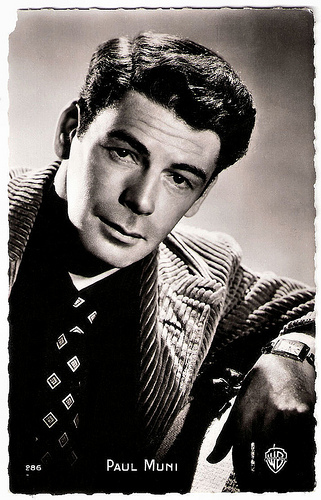
French postcard by Editions P.I., Paris, no. 286. Photo: Warner Bros.
A cruel, explosive gangster
Paul Muni was born Frederich Meshilem Meier Weisenfreund in 1895 in Lwów Lemberg, Galicia, a province of the Austro-Hungarian Empire (now Lviv, Ukraine). His parents were Salli and Phillip Weisenfreund, both actors in a travelling Yiddish repertory company. He learned Yiddish as his first language. The family immigrated to America in 1899.
The Weisenfreund family settled in Chicago, where Paul grew up. He started his acting career in the Yiddish theatre with his parents. Naturally talented in acting, he wanted to become a professional actor but this was unacceptable to his father who wanted his son to become a musician. However, Muni was adamant and his father reluctantly agreed to let him pursue his passion.
As a teenager, he developed a skill in creating makeup, which enabled him to play much older characters. At the age of 12, he played the stage role of an 80-year-old man. He was quickly recognised by Maurice Schwartz, who signed him up with his Yiddish Art Theatre in New York in 1918. After 4 years, he moved to other Yiddish theatres until 1926.
Paul Muni was a very reserved and shy person in real life. In 1921, he married Bella Finkel, an actress in the Yiddish theatre. They remained married until Muni's death in 1967.
Muni began acting on Broadway in 1926. His first role was that of an elderly Jewish man in the play We Americans, written by playwrights Max Siegel and Milton Herbert Gropper. It was the first time that he ever acted in English.
In 1929, Muni was signed by Fox. His name was simplified and anglicised to Paul Muni (he had the nickname 'Moony' when he was young). His acting talents were quickly recognised and made his film debut in the drama The Valiant (William K. Howard, 1929) with Marguerite Churchill. For his portrayal of a murderer, he received an Oscar nomination, although the film did poorly at the box office.
In his second film Seven Faces (Berthold Viertel, 1929), he played seven different characters. He was given the nickname "The New Lon Chaney ", but the film was again a financial failure. Unhappy with the roles offered to him, he returned to Broadway, where he starred in a major hit play, Counselor at Law (1931-1933).
Paul Muni soon returned to Hollywood to star as the cruel, explosive gangster Antonio 'Tony' Camonte in the original Scarface (Howard Hawks, 1932), part of a cycle of gangster films at the time. The film was written by Ben Hecht, who based his screenplay on Armitage Trail's 1929 novel of the same title, which is loosely based on the rise and fall of Al Capone.
The plot centres on Camonte, who aggressively and violently moves up the ranks in the Chicago gangland world. A version of the Saint Valentine's Day Massacre is depicted. A man of 5'9" height (175.3 cm), Muni wore small lifts (adding three or four inches) and padding to appear more hulking and ape-like as Tony. The film was the basis for Scarface (Brian De Palma, 1983) starring Al Pacino.
In the crime drama I Am a Fugitive from a Chain Gang (Mervyn LeRoy, 1932), he played a wrongfully convicted convict on a chain gang who escapes to Chicago. For his role, Muni was nominated for an Oscar for Best Actor. Audiences in the United States who saw the film began to question the legitimacy of the United States legal system, and in January 1933, the film's protagonist, Robert Elliott Burns, who was still imprisoned in New Jersey, and a number of other chain gang prisoners nationwide in the United States, were able to appeal and were released.
The acclaim that Paul Muni received as a result of this performance so impressed Warner Bros., they signed him to a long-term contract, publicising him as "the screen's greatest actor".
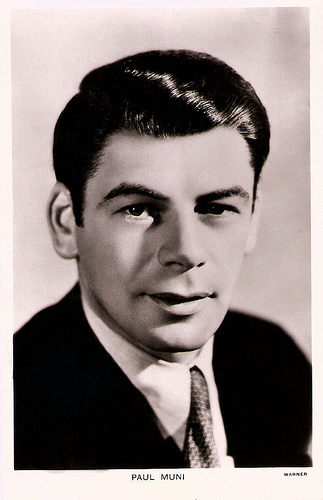
British postcard in the Picturegoer Series, no. 838. Photo: Warner.
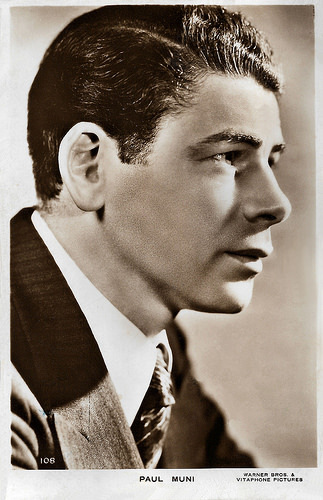
British Real Photograph postcard, no. 108. Photo: Warner Bros. Vitaphone Pictures.
Louis Pasteur
During the 1930s, Paul Muni became one of the most prestigious actors at the Warner Bros., and was given the rare privilege of choosing which parts he wanted. His reputation as a prominent stage actor prevented Hollywood from molding him into a marketable image or into a typical big-screen leading man. Muni’s film roles were diverse and generally superior to most Hollywood fare.
In 1935, Muni starred as a coal miner involved in a union dispute in Black Fury (Michael Curtiz, 1935) with Karen Morley, and for his performance he earned his third Oscar nomination (as a write-in candidate).
Muni persuaded Warner Bros. to take a financial risk by producing the historical biography The Story of Louis Pasteur (William Dieterle, 1935). Muni played the 19th century chemist who developed major advances in microbiology, which revolutionised agriculture and medicine, to prove that his medical theories will save lives. It was first of Muni's many biographical roles. The sudden success of Pasteur gave Warner's 'box office gold'. For his performance, Muni won an Oscar and the Volpi Cup for Best Actor from the Venice Film Festival.
Muni played other historical figures, including French author Émile Zola in The Life of Emile Zola (William Dieterle, 1937), for which he was nominated for an Oscar. The film won Best Picture and was interpreted as indirectly attacking the repression of Nazi Germany. He also played the lead role as the Mexican national hero Benito Juárez in Juarez (William Dieterle, 1939) opposite Bette Davis.
His acting quality, usually playing a powerful character, was partly a result of his intense preparation for his parts, often immersing himself in study of the real character's traits and mannerisms. He was also highly skilled in using makeup techniques, a talent he learned from his parents, who were also actors, and from his early years on stage with the Yiddish theatre in Chicago.
In 1937, Muni played a Chinese peasant, with a new bride, in a film adaptation of Pearl Buck's novel The Good Earth (Sidney Franklin, 1937). It co-starred Luise Rainer as his wife. She won an Academy Award for her part. The film was a recreation of a revolutionary period in China, and included special effects for a locust attack and the overthrow of the government.
Dissatisfied with life in Hollywood, Muni chose not to renew his contract. He returned to the screen only occasionally in later years, for such roles as Frédéric Chopin's teacher in A Song to Remember (Charles Vidor, 1945) with Merle Oberon . In 1946, he starred in a rare comic performance, Angel on My Shoulder (Archie Mayo, 1946), playing a gangster whose early death prompts the Devil (played by Claude Rains ) to make mischief by putting his soul into the body of a judge. His new identity turns the former criminal into a model citizen.
In 1946, he appeared on Broadway in A Flag is Born, written by Ben Hecht, to help promote the creation of a Jewish state in Israel. This play was directed by Luther Adler and co-starred Marlon Brando . At London's Phoenix Theatre, in 1949, Muni began a run as Willy Loman in the first English production of Death of a Salesman by Arthur Miller. He took over from Lee J. Cobb, who had played the principal role in the original Broadway production. Both productions were directed by Elia Kazan.
In Italy, he appeared in the drama Imbarco a mezzanotte/Stranger on the Prowl (Joseph Losey, 1952). Muni travelled to Italy to star in the film partly as an act of solidarity and support for blacklisted friends living there in exile.
A few years later, during 1955 and 1956, Muni had his biggest stage success in the United States as the crusading lawyer, Henry Drummond (based on Clarence Darrow), in Inherit the Wind, winning a Tony Award for Best Performance by a Leading Actor in a Play. In late August 1955, Muni was forced to withdraw from the play, due to a serious eye ailment causing deterioration in his eyesight.
His last film role was as a crusading doctor in The Last Angry Man (Daniel Mann, 1959), and he was again nominated for an Oscar. After that, Muni mostly retired from acting to deal with failing eyesight and other health problems.
Over the years, he became increasingly dependent on his wife, Bella, a dependence which increased as his failing eyesight turned to blindness in his final years. He made his final screen appearance on television, in a guest role on the dramatic series Saints and Sinners (1962).
Paul Muni died of a heart disorder in Montecito, California, in 1967. He was 71 and had made 22 films and also starred in numerous Broadway plays. He is interred in the Hollywood Forever Cemetery, Hollywood.
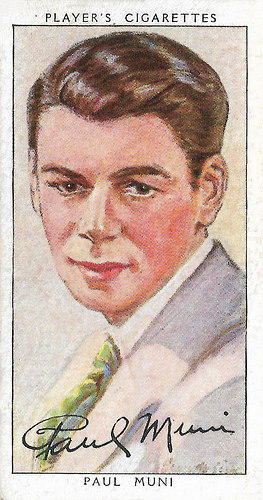
British cigarette card in the Third Film Stars series by John Player & Sons, no. 32. Photo: Warner - First National. Collection: Geoffrey Donaldson Institute.
Sources: Encyclopaedia Britannica, Biography.com, Wikipedia and .

French postcard by Editions P.I., Paris, no. 286. Photo: Warner Bros.
A cruel, explosive gangster
Paul Muni was born Frederich Meshilem Meier Weisenfreund in 1895 in Lwów Lemberg, Galicia, a province of the Austro-Hungarian Empire (now Lviv, Ukraine). His parents were Salli and Phillip Weisenfreund, both actors in a travelling Yiddish repertory company. He learned Yiddish as his first language. The family immigrated to America in 1899.
The Weisenfreund family settled in Chicago, where Paul grew up. He started his acting career in the Yiddish theatre with his parents. Naturally talented in acting, he wanted to become a professional actor but this was unacceptable to his father who wanted his son to become a musician. However, Muni was adamant and his father reluctantly agreed to let him pursue his passion.
As a teenager, he developed a skill in creating makeup, which enabled him to play much older characters. At the age of 12, he played the stage role of an 80-year-old man. He was quickly recognised by Maurice Schwartz, who signed him up with his Yiddish Art Theatre in New York in 1918. After 4 years, he moved to other Yiddish theatres until 1926.
Paul Muni was a very reserved and shy person in real life. In 1921, he married Bella Finkel, an actress in the Yiddish theatre. They remained married until Muni's death in 1967.
Muni began acting on Broadway in 1926. His first role was that of an elderly Jewish man in the play We Americans, written by playwrights Max Siegel and Milton Herbert Gropper. It was the first time that he ever acted in English.
In 1929, Muni was signed by Fox. His name was simplified and anglicised to Paul Muni (he had the nickname 'Moony' when he was young). His acting talents were quickly recognised and made his film debut in the drama The Valiant (William K. Howard, 1929) with Marguerite Churchill. For his portrayal of a murderer, he received an Oscar nomination, although the film did poorly at the box office.
In his second film Seven Faces (Berthold Viertel, 1929), he played seven different characters. He was given the nickname "The New Lon Chaney ", but the film was again a financial failure. Unhappy with the roles offered to him, he returned to Broadway, where he starred in a major hit play, Counselor at Law (1931-1933).
Paul Muni soon returned to Hollywood to star as the cruel, explosive gangster Antonio 'Tony' Camonte in the original Scarface (Howard Hawks, 1932), part of a cycle of gangster films at the time. The film was written by Ben Hecht, who based his screenplay on Armitage Trail's 1929 novel of the same title, which is loosely based on the rise and fall of Al Capone.
The plot centres on Camonte, who aggressively and violently moves up the ranks in the Chicago gangland world. A version of the Saint Valentine's Day Massacre is depicted. A man of 5'9" height (175.3 cm), Muni wore small lifts (adding three or four inches) and padding to appear more hulking and ape-like as Tony. The film was the basis for Scarface (Brian De Palma, 1983) starring Al Pacino.
In the crime drama I Am a Fugitive from a Chain Gang (Mervyn LeRoy, 1932), he played a wrongfully convicted convict on a chain gang who escapes to Chicago. For his role, Muni was nominated for an Oscar for Best Actor. Audiences in the United States who saw the film began to question the legitimacy of the United States legal system, and in January 1933, the film's protagonist, Robert Elliott Burns, who was still imprisoned in New Jersey, and a number of other chain gang prisoners nationwide in the United States, were able to appeal and were released.
The acclaim that Paul Muni received as a result of this performance so impressed Warner Bros., they signed him to a long-term contract, publicising him as "the screen's greatest actor".

British postcard in the Picturegoer Series, no. 838. Photo: Warner.

British Real Photograph postcard, no. 108. Photo: Warner Bros. Vitaphone Pictures.
Louis Pasteur
During the 1930s, Paul Muni became one of the most prestigious actors at the Warner Bros., and was given the rare privilege of choosing which parts he wanted. His reputation as a prominent stage actor prevented Hollywood from molding him into a marketable image or into a typical big-screen leading man. Muni’s film roles were diverse and generally superior to most Hollywood fare.
In 1935, Muni starred as a coal miner involved in a union dispute in Black Fury (Michael Curtiz, 1935) with Karen Morley, and for his performance he earned his third Oscar nomination (as a write-in candidate).
Muni persuaded Warner Bros. to take a financial risk by producing the historical biography The Story of Louis Pasteur (William Dieterle, 1935). Muni played the 19th century chemist who developed major advances in microbiology, which revolutionised agriculture and medicine, to prove that his medical theories will save lives. It was first of Muni's many biographical roles. The sudden success of Pasteur gave Warner's 'box office gold'. For his performance, Muni won an Oscar and the Volpi Cup for Best Actor from the Venice Film Festival.
Muni played other historical figures, including French author Émile Zola in The Life of Emile Zola (William Dieterle, 1937), for which he was nominated for an Oscar. The film won Best Picture and was interpreted as indirectly attacking the repression of Nazi Germany. He also played the lead role as the Mexican national hero Benito Juárez in Juarez (William Dieterle, 1939) opposite Bette Davis.
His acting quality, usually playing a powerful character, was partly a result of his intense preparation for his parts, often immersing himself in study of the real character's traits and mannerisms. He was also highly skilled in using makeup techniques, a talent he learned from his parents, who were also actors, and from his early years on stage with the Yiddish theatre in Chicago.
In 1937, Muni played a Chinese peasant, with a new bride, in a film adaptation of Pearl Buck's novel The Good Earth (Sidney Franklin, 1937). It co-starred Luise Rainer as his wife. She won an Academy Award for her part. The film was a recreation of a revolutionary period in China, and included special effects for a locust attack and the overthrow of the government.
Dissatisfied with life in Hollywood, Muni chose not to renew his contract. He returned to the screen only occasionally in later years, for such roles as Frédéric Chopin's teacher in A Song to Remember (Charles Vidor, 1945) with Merle Oberon . In 1946, he starred in a rare comic performance, Angel on My Shoulder (Archie Mayo, 1946), playing a gangster whose early death prompts the Devil (played by Claude Rains ) to make mischief by putting his soul into the body of a judge. His new identity turns the former criminal into a model citizen.
In 1946, he appeared on Broadway in A Flag is Born, written by Ben Hecht, to help promote the creation of a Jewish state in Israel. This play was directed by Luther Adler and co-starred Marlon Brando . At London's Phoenix Theatre, in 1949, Muni began a run as Willy Loman in the first English production of Death of a Salesman by Arthur Miller. He took over from Lee J. Cobb, who had played the principal role in the original Broadway production. Both productions were directed by Elia Kazan.
In Italy, he appeared in the drama Imbarco a mezzanotte/Stranger on the Prowl (Joseph Losey, 1952). Muni travelled to Italy to star in the film partly as an act of solidarity and support for blacklisted friends living there in exile.
A few years later, during 1955 and 1956, Muni had his biggest stage success in the United States as the crusading lawyer, Henry Drummond (based on Clarence Darrow), in Inherit the Wind, winning a Tony Award for Best Performance by a Leading Actor in a Play. In late August 1955, Muni was forced to withdraw from the play, due to a serious eye ailment causing deterioration in his eyesight.
His last film role was as a crusading doctor in The Last Angry Man (Daniel Mann, 1959), and he was again nominated for an Oscar. After that, Muni mostly retired from acting to deal with failing eyesight and other health problems.
Over the years, he became increasingly dependent on his wife, Bella, a dependence which increased as his failing eyesight turned to blindness in his final years. He made his final screen appearance on television, in a guest role on the dramatic series Saints and Sinners (1962).
Paul Muni died of a heart disorder in Montecito, California, in 1967. He was 71 and had made 22 films and also starred in numerous Broadway plays. He is interred in the Hollywood Forever Cemetery, Hollywood.

British cigarette card in the Third Film Stars series by John Player & Sons, no. 32. Photo: Warner - First National. Collection: Geoffrey Donaldson Institute.
Sources: Encyclopaedia Britannica, Biography.com, Wikipedia and .
Published on November 10, 2018 22:00
November 9, 2018
Photo by Warner Bros.
Warner Bros. is an American entertainment conglomerate founded in 1923 and especially known for its film studio. Its name originated from the four founding Warner brothers: Harry, Albert, Sam, and Jack Warner. They opened their first film studio in 1918 and formally incorporated Warner Brothers Pictures in 1923. This post concentrates on the Warner Bros. photo legacy from the 1920s to the 1960s, when Warner Bros became known for its tightly budgeted, technically competent entertainment films. Photographers who worked for the photo department of the studio include Scotty Welbourne, John Engstead and George Hurrell.
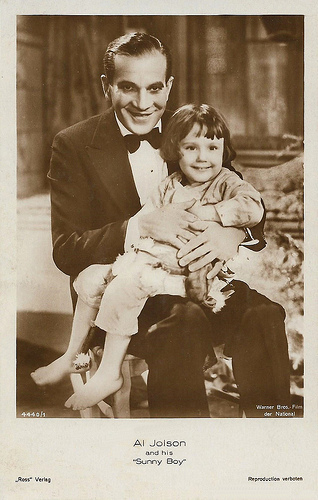
German postcard by Ross Verlag, no. 4440/1, 1929-1930. Photo: Warner Bros. Film, National. Al Jolson and his 'Sunny Boy' (Davey Lee) in the early sound film The Singing Fool (Lloyd Bacon, 1928). At the age of three, Davey Lee made his debut in one of the early talkies The Singing Fool (Lloyd Bacon, 1928). The Singing Fool remained Warner's most successful film for ten years. The theme song Sonny Boy became the first film song to sell over a million copies. Davey appeared in six films between 1928 and 1930. Then, his mother took him out of films so that he could have a normal childhood.
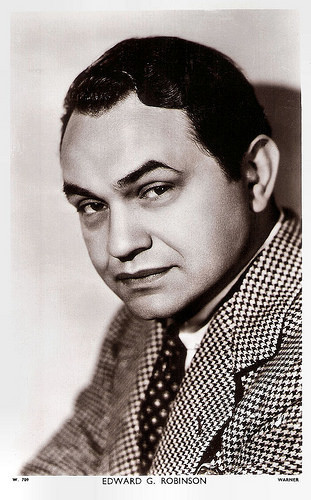
British postcard in the Picturegoer Series, London, no. W. 709. Photo: Warner. Edward G. Robinson is best remembered for his cold-eyed Machiavellian gangster roles, such as his star-making film Little Caesar (1931) as snarling, murderous thug Caesar Enrico ‘Rico’ Bandello.
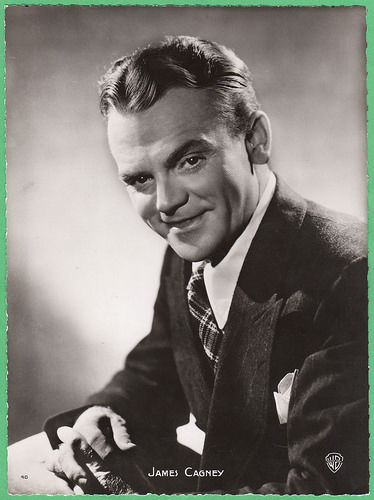
Belgian collectors card by Chocolaterie Clovis, Pepinster, no. 40. Photo: Warner Bros. Collection: Amit Benyovits. After Little Caesar, the studio's next effort was The Public Enemy. It made James Cagney arguably the studio's new top star, and Warner Bros. made more gangster films.

French postcard by Editions P.I., Paris, no. 286. Photo: Warner Bros. During the 1930s, Paul Muni was considered one of the most prestigious actors at the Warner Bros. studio, and was given the rare privilege of choosing which parts he wanted. His acting quality, usually playing a powerful character, such as the lead in Scarface (Howard Hawks, 1932), was partly a result of his intense preparation for his parts, often immersing himself in study of the real character's traits and mannerisms.
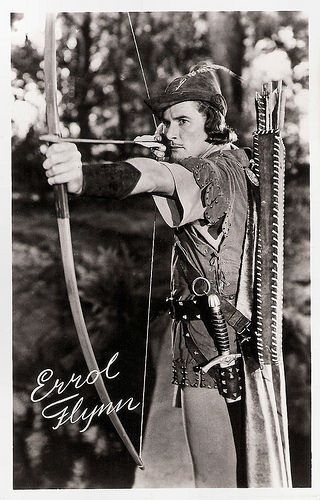
Dutch card. Photo: Warner Bros. Publicity still for The Adventures of Robin Hood (Michael Curtiz, William Keighley, 1938). Errol Flynn achieved fame in Hollywood with his suave, debonair, devil-may-care attitude. He was known for his romantic Swashbuckler roles in Warner films like Captain Blood (Michael Curtiz, 1935) and The Adventures of Robin Hood (Michael Curtiz, 1938), often co-starring with Olivia de Havilland.
Torn from today's headlines
Warner Bros' first important deal was the acquisition of the rights to Avery Hopwood's 1919 Broadway play, The Gold Diggers, from theatrical impresario David Belasco. However, Rin Tin Tin, a dog brought from France after World War I by an American soldier, established their reputation. Rin Tin Tin debuted in the feature Where the North Begins. The movie was so successful that Jack signed the dog to star in more films for $1,000 per week. Rin Tin Tin became the studio's top star.
In the mid-1920s, the company ran into financial difficulties. Sam Warner persuaded his brothers to collaborate in developing a patent on a process (Vitaphone) that made the 'talkies' possible, revolutionising the film industry.
In 1927, Warner Bros. made cinematic history with the release of the first film with synchronised songs and dialogue, The Jazz Singer (Alan Crosland, 1927). Thanks to the success of The Jazz Singer, the studio was cash-rich. Jolson's next film for the company, The Singing Fool (Lloyd Bacon, 1928) was also a success. With the collapse of the market for musicals, Warner Bros., under Daryl F. Zanuck, turned to more socially realistic storylines.
In the early 1930s the company started the craze for gangster films with Little Caesar (Mervyn LeRoy, 1931) with Edward G. Robinson, The Public Enemy (William A. Wellman, 1931) with James Cagney, and Scarface (Howard Hawks, 1932) with Paul Muni. For its many films about gangsters; Warner Bros. soon became known as a 'gangster studio'.
In February 1933, Warner Bros. produced 42nd Street (Lloyd Bacon, 1933), a very successful musical. Warner assigned Bacon to more expensive productions including Footlight Parade (Lloyd Bacon, 1933), Wonder Bar (Lloyd Bacon, 1934), and Gold Diggers of 1933 (Mervyn LeRoy, 1933) that saved the company from bankruptcy. In the wake of 42nd Street's success, the studio produced profitable musicals. These starred Ruby Keeler and Dick Powell and were mostly directed by Busby Berkeley.
In 1935, the revival of the musical was affected by Busby Berkeley's arrest for killing three people while driving drunk. By the end of the year, people again tired of Warner Bros. musical extravaganzas, and the studio — after the huge profits made by Captain Blood (Michael Curtiz, 1935) - shifted its focus to Errol Flynn swashbucklers and dramas featuring such stars as Bette Davis, Humphrey Bogart, and John Garfield.
Films made at Warner Bros. have been historically associated with a distinctive style. Warner films have been described as contemporary stories 'torn from today's headlines' distinguished by a cynicism and hard-bitten realism in style, tone, and technique.

French postcard by Editions P.I., Paris, no. 285. Photo: Warner Bros. Olivia de Havilland co-starred with Errol Flynn in eight Warner films. For the classic Gone with the Wind (Victor Fleming, 1939), she received her first Oscar nomination. In 1943, de Havilland (whom Warner frequently loaned to other studios) sued Warner for breach of contract. Warner responded by sending 150 telegrams to different film production companies, warning them not to hire her for any role. Afterwards, de Havilland discovered employment contracts in California could only last seven years; de Havilland had been under contract with the studio since 1935. The court ruled in de Havilland's favour and she left the studio.
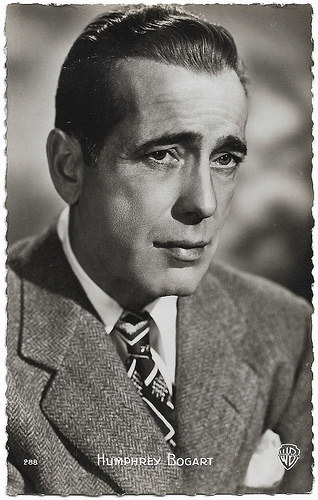
French postcard by Editions P.I., Paris, no. 288. Photo: Warner Bros. After George Raft had turned the role down, Warner Bros. gave Humphrey Bogart the role of 'Mad Dog' Roy Earle in High Sierra (Raoul Walsh, 1941), which helped establish him as a top star. Following High Sierra and after Raft had once again turned the part down, Bogart was given the leading role in John Huston's successful 1941 remake of the studio's 1931 pre-Code film, The Maltese Falcon, based upon the Dashiell Hammett novel. Bogart's star continued to ascend with the Howard Hawks-directed Film Noir masterwork The Big Sleep (1946), and two consummate Huston films, The Treasure of the Sierra Madre (1948) and Key Largo (1948).
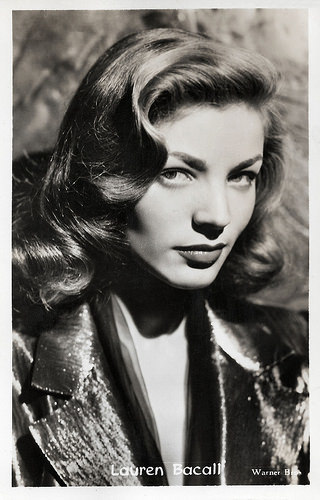
Dutch postcard. Photo: Warner Bros. Publicity still for The Big Sleep (Howard Hawks, 1946). Lauren Bacall became an overnight star as 'Slim' opposite Humphrey Bogart in her memorable film debut in To Have and Have Not (Howard Hawks, 1942). She became known for her distinctive husky voice and glamorous looks in Film Noirs as The Big Sleep (Howard Hawks, 1946), Dark Passage (Delmer Daves, 1947), and Key Largo (John Huston, 1948).
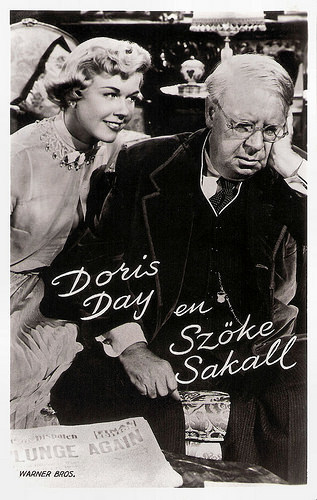
Dutch postcard by Takken / 't Sticht, no. AX 343. Photo: Warner Bros. Publicity still for Tea for Two (David Butler, 1950) with Doris Day and Szöke Szakáll . Tea for Two was the first film for which Day received top-billing. Many popular musicals and a string of romantic comedies with Rock Hudson would follow.
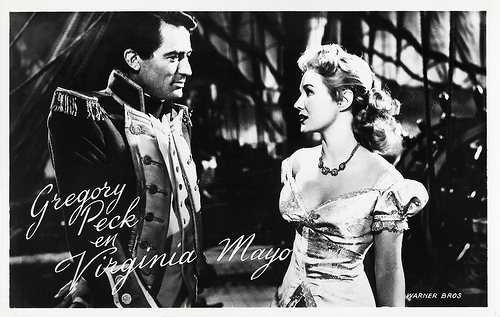
Dutch postcard by Takken, Utrecht, no. 610. Photo: Warner Bros. Publicity still for Captain Horatio Hornblower (Raoul Walsh, 1951) with Gregory Peck and Virginia Mayo. Virginia Mayo is best known for her comedies with Danny Kaye, such as The Kid from Brooklyn (Norman Z. McLeod, 1946), and The Secret Life of Walter Mitty (Norman Z. McLeod, 1947). She personified the dream girl or girl-next-door and audiences — particularly males — locked to theatres just to see her blonde hair and classic looks on-screen in Technicolor. It made Mayo Warner Brothers biggest box office money maker in the late 1940s.
Sustaining its trademark Film Noirs, dark dramas, and women's pictures
Among Warner Bros.’s best-known films of the 1940s were such classics as The Maltese Falcon (John Huston, 1941) and Casablanca (Michael Curtis, 1942), both starring Humphrey Bogart. Warner Bros. produced very few top hits during the post-war era, although it did sustain its trademark Film Noirs, dark dramas, and women's pictures. Bette Davis's star was rapidly falling, but former MGM diva Joan Crawford came out of retirement to star in several Warner Bros. hits, including Mildred Pierce (1945) and Humoresque (1946).
Warner Bros. continued to create new stars, including Lauren Bacall and Doris Day. They also made such successful films as A Streetcar Named Desire (Elia Kazan, 1951) with Marlon Brando , and Rebel Without a Cause (Nicholas Ray, 1955) with James Dean .
During this period Warner Brothers also expanded into television with the premiere of the Western series Cheyenne in 1955. Cheyenne, starring Clint Walker, was television's first hour-long Western. Two episodes were placed together for feature film release outside the United States.
In the tradition of its B movies, the studio followed up with a series of rapidly produced popular Westerns, such as writer/producer Roy Huggins' critically lauded Maverick (1957–1962) with Jack Kelly, James Garner and Roger Moore , as well as Sugarfoot (1957-1961), Bronco (1958), and Lawman (1958-1962). The success of these series helped to make up for losses in the film business.
As a result, Jack Warner decided to emphasise television production. Warner's also produced a series of popular private detective shows beginning with 77 Sunset Strip (1958–1964) starring Efrem Zimbalist Jr., Edd Byrnes, and Roger Smith, followed by Hawaiian Eye (1959–1963), Bourbon Street Beat (1960) and Surfside 6 (1960–1962).
With the success of the studio's film of Broadway play My Fair Lady (George Cukor, 1964), as well as its soundtrack, Warner Bros. Records became a profitable subsidiary. The film Who's Afraid Of Virginia Woolf? (Mike Nichols, 1966) with Elizabeth Taylor and Richard Burton was a also huge success. In November 1966, Jack gave in to advancing age and changing times, selling control of the studio and music business to Seven Arts Productions.
Two years later, however, Warner was sold to the Kinney Corporation, which was headed by Steven J. Ross. He transformed Kinney into the media and entertainment empire Warner Communications, and Warner Bros., Inc., as it was renamed, became a highly diversified subsidiary, venturing into such areas as music, video games, and comic books. Despite such expansion, Warner Brothers remained focused on films and television programs. In 1990 Warner Communications merged with Time Inc. to form Time Warner Inc., the largest media and entertainment corporation in the world.
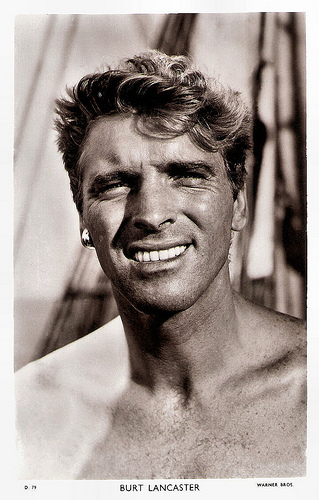
British postcard in the Picturegoer Series, no. D 79. Photo: Warner Bros. Publicity still for The Crimson Pirate (Robert Siodmak, 1952). Burt Lancaster took the lead in such popular successes as the Technicolor swashbucklers The Flame and the Arrow (Jacques Tourneur, 1950) and The Crimson Pirate (Robert Siodmak, 1952), and the Western Vera Cruz (Robert Aldrich, 1954). The films were produced by Lancaster's own company but distributed by Warner Bros.
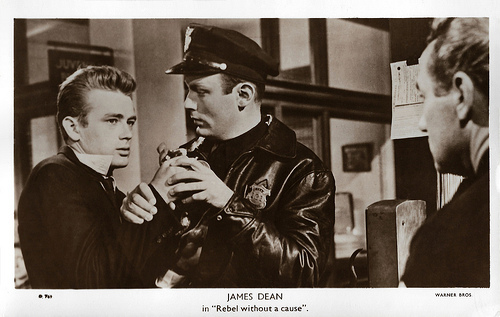
British postcard in the Picturegoer Series, London, no. D 769. Photo: Warner Bros. Publicity still for Rebel Without a Cause (Nicholas Ray, 1955). James Dean played for Warner Bros in three films that defined his stardom are as troubled teenager. He was Jim Stark in Rebel Without a Cause (1955), loner Cal Trask in East of Eden (Elia Kazan, 1955) and surly ranch hand Jett Rink in Giant (George Stevens, 1956). After his death in a car crash, the only 24-years-old Dean became the first actor to receive a posthumous Academy Award nomination for Best Actor.

Vintage postcard, no. SP568. In the 1950s, Clint Walker with his broad shoulders and slim waist almost single-handedly started the Western craze on TV in his role as Cheyenne Bodie in Cheyenne (1955-1962). Cheyenne Bodie was a roaming cowboy hero in the post-American Civil War era. Cheyenne originally appeared as part of Warner Bros Presents rotating with adaptations of Kings Row and Casablanca. Cheyenne turned out to be the break out hit for Walker. While the series regularly capitalised on Walker's rugged frame with frequent bare-chested scenes, it was also well written and acted. It proved hugely popular for eight seasons. Walker's pleasant baritone singing voice was also occasionally utilised on the series and led Warner Brothers to produce an album of Walker doing traditional songs and ballads.

Spanish postcard by Archivo Bermejo, no. 5495. Photo: Warner Bros. Publicity still for Lafayette Escadrille (William A Wellman, 1958). With his blond, tanned, surfer-boy good looks, Tab Hunter was one of Hollywood’s hottest teen idols of the 1950s era. The American actor, singer, and author portrayed boy-next-door marines, cowboys and swoon-bait sweethearts, and had a huge hit with the song Young Love (1957). In 1958, the studio launched Warner Bros. Records.
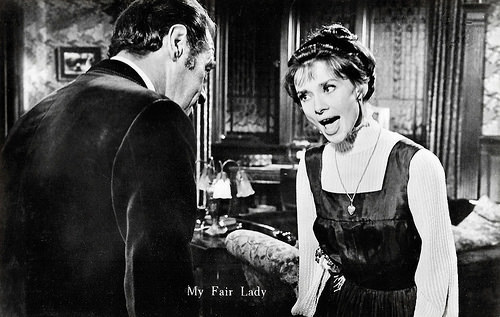
Dutch postcard by Int. Filmpers, Amsterdam, no. 1306. Photo: Warner Bros. Rex Harrison and Audrey Hepburn in My Fair Lady (George Cukor, 1964).
Sources: Encyclopedia Britanica, Film Reference, and Wikipedia.

German postcard by Ross Verlag, no. 4440/1, 1929-1930. Photo: Warner Bros. Film, National. Al Jolson and his 'Sunny Boy' (Davey Lee) in the early sound film The Singing Fool (Lloyd Bacon, 1928). At the age of three, Davey Lee made his debut in one of the early talkies The Singing Fool (Lloyd Bacon, 1928). The Singing Fool remained Warner's most successful film for ten years. The theme song Sonny Boy became the first film song to sell over a million copies. Davey appeared in six films between 1928 and 1930. Then, his mother took him out of films so that he could have a normal childhood.

British postcard in the Picturegoer Series, London, no. W. 709. Photo: Warner. Edward G. Robinson is best remembered for his cold-eyed Machiavellian gangster roles, such as his star-making film Little Caesar (1931) as snarling, murderous thug Caesar Enrico ‘Rico’ Bandello.

Belgian collectors card by Chocolaterie Clovis, Pepinster, no. 40. Photo: Warner Bros. Collection: Amit Benyovits. After Little Caesar, the studio's next effort was The Public Enemy. It made James Cagney arguably the studio's new top star, and Warner Bros. made more gangster films.

French postcard by Editions P.I., Paris, no. 286. Photo: Warner Bros. During the 1930s, Paul Muni was considered one of the most prestigious actors at the Warner Bros. studio, and was given the rare privilege of choosing which parts he wanted. His acting quality, usually playing a powerful character, such as the lead in Scarface (Howard Hawks, 1932), was partly a result of his intense preparation for his parts, often immersing himself in study of the real character's traits and mannerisms.

Dutch card. Photo: Warner Bros. Publicity still for The Adventures of Robin Hood (Michael Curtiz, William Keighley, 1938). Errol Flynn achieved fame in Hollywood with his suave, debonair, devil-may-care attitude. He was known for his romantic Swashbuckler roles in Warner films like Captain Blood (Michael Curtiz, 1935) and The Adventures of Robin Hood (Michael Curtiz, 1938), often co-starring with Olivia de Havilland.
Torn from today's headlines
Warner Bros' first important deal was the acquisition of the rights to Avery Hopwood's 1919 Broadway play, The Gold Diggers, from theatrical impresario David Belasco. However, Rin Tin Tin, a dog brought from France after World War I by an American soldier, established their reputation. Rin Tin Tin debuted in the feature Where the North Begins. The movie was so successful that Jack signed the dog to star in more films for $1,000 per week. Rin Tin Tin became the studio's top star.
In the mid-1920s, the company ran into financial difficulties. Sam Warner persuaded his brothers to collaborate in developing a patent on a process (Vitaphone) that made the 'talkies' possible, revolutionising the film industry.
In 1927, Warner Bros. made cinematic history with the release of the first film with synchronised songs and dialogue, The Jazz Singer (Alan Crosland, 1927). Thanks to the success of The Jazz Singer, the studio was cash-rich. Jolson's next film for the company, The Singing Fool (Lloyd Bacon, 1928) was also a success. With the collapse of the market for musicals, Warner Bros., under Daryl F. Zanuck, turned to more socially realistic storylines.
In the early 1930s the company started the craze for gangster films with Little Caesar (Mervyn LeRoy, 1931) with Edward G. Robinson, The Public Enemy (William A. Wellman, 1931) with James Cagney, and Scarface (Howard Hawks, 1932) with Paul Muni. For its many films about gangsters; Warner Bros. soon became known as a 'gangster studio'.
In February 1933, Warner Bros. produced 42nd Street (Lloyd Bacon, 1933), a very successful musical. Warner assigned Bacon to more expensive productions including Footlight Parade (Lloyd Bacon, 1933), Wonder Bar (Lloyd Bacon, 1934), and Gold Diggers of 1933 (Mervyn LeRoy, 1933) that saved the company from bankruptcy. In the wake of 42nd Street's success, the studio produced profitable musicals. These starred Ruby Keeler and Dick Powell and were mostly directed by Busby Berkeley.
In 1935, the revival of the musical was affected by Busby Berkeley's arrest for killing three people while driving drunk. By the end of the year, people again tired of Warner Bros. musical extravaganzas, and the studio — after the huge profits made by Captain Blood (Michael Curtiz, 1935) - shifted its focus to Errol Flynn swashbucklers and dramas featuring such stars as Bette Davis, Humphrey Bogart, and John Garfield.
Films made at Warner Bros. have been historically associated with a distinctive style. Warner films have been described as contemporary stories 'torn from today's headlines' distinguished by a cynicism and hard-bitten realism in style, tone, and technique.

French postcard by Editions P.I., Paris, no. 285. Photo: Warner Bros. Olivia de Havilland co-starred with Errol Flynn in eight Warner films. For the classic Gone with the Wind (Victor Fleming, 1939), she received her first Oscar nomination. In 1943, de Havilland (whom Warner frequently loaned to other studios) sued Warner for breach of contract. Warner responded by sending 150 telegrams to different film production companies, warning them not to hire her for any role. Afterwards, de Havilland discovered employment contracts in California could only last seven years; de Havilland had been under contract with the studio since 1935. The court ruled in de Havilland's favour and she left the studio.

French postcard by Editions P.I., Paris, no. 288. Photo: Warner Bros. After George Raft had turned the role down, Warner Bros. gave Humphrey Bogart the role of 'Mad Dog' Roy Earle in High Sierra (Raoul Walsh, 1941), which helped establish him as a top star. Following High Sierra and after Raft had once again turned the part down, Bogart was given the leading role in John Huston's successful 1941 remake of the studio's 1931 pre-Code film, The Maltese Falcon, based upon the Dashiell Hammett novel. Bogart's star continued to ascend with the Howard Hawks-directed Film Noir masterwork The Big Sleep (1946), and two consummate Huston films, The Treasure of the Sierra Madre (1948) and Key Largo (1948).

Dutch postcard. Photo: Warner Bros. Publicity still for The Big Sleep (Howard Hawks, 1946). Lauren Bacall became an overnight star as 'Slim' opposite Humphrey Bogart in her memorable film debut in To Have and Have Not (Howard Hawks, 1942). She became known for her distinctive husky voice and glamorous looks in Film Noirs as The Big Sleep (Howard Hawks, 1946), Dark Passage (Delmer Daves, 1947), and Key Largo (John Huston, 1948).

Dutch postcard by Takken / 't Sticht, no. AX 343. Photo: Warner Bros. Publicity still for Tea for Two (David Butler, 1950) with Doris Day and Szöke Szakáll . Tea for Two was the first film for which Day received top-billing. Many popular musicals and a string of romantic comedies with Rock Hudson would follow.

Dutch postcard by Takken, Utrecht, no. 610. Photo: Warner Bros. Publicity still for Captain Horatio Hornblower (Raoul Walsh, 1951) with Gregory Peck and Virginia Mayo. Virginia Mayo is best known for her comedies with Danny Kaye, such as The Kid from Brooklyn (Norman Z. McLeod, 1946), and The Secret Life of Walter Mitty (Norman Z. McLeod, 1947). She personified the dream girl or girl-next-door and audiences — particularly males — locked to theatres just to see her blonde hair and classic looks on-screen in Technicolor. It made Mayo Warner Brothers biggest box office money maker in the late 1940s.
Sustaining its trademark Film Noirs, dark dramas, and women's pictures
Among Warner Bros.’s best-known films of the 1940s were such classics as The Maltese Falcon (John Huston, 1941) and Casablanca (Michael Curtis, 1942), both starring Humphrey Bogart. Warner Bros. produced very few top hits during the post-war era, although it did sustain its trademark Film Noirs, dark dramas, and women's pictures. Bette Davis's star was rapidly falling, but former MGM diva Joan Crawford came out of retirement to star in several Warner Bros. hits, including Mildred Pierce (1945) and Humoresque (1946).
Warner Bros. continued to create new stars, including Lauren Bacall and Doris Day. They also made such successful films as A Streetcar Named Desire (Elia Kazan, 1951) with Marlon Brando , and Rebel Without a Cause (Nicholas Ray, 1955) with James Dean .
During this period Warner Brothers also expanded into television with the premiere of the Western series Cheyenne in 1955. Cheyenne, starring Clint Walker, was television's first hour-long Western. Two episodes were placed together for feature film release outside the United States.
In the tradition of its B movies, the studio followed up with a series of rapidly produced popular Westerns, such as writer/producer Roy Huggins' critically lauded Maverick (1957–1962) with Jack Kelly, James Garner and Roger Moore , as well as Sugarfoot (1957-1961), Bronco (1958), and Lawman (1958-1962). The success of these series helped to make up for losses in the film business.
As a result, Jack Warner decided to emphasise television production. Warner's also produced a series of popular private detective shows beginning with 77 Sunset Strip (1958–1964) starring Efrem Zimbalist Jr., Edd Byrnes, and Roger Smith, followed by Hawaiian Eye (1959–1963), Bourbon Street Beat (1960) and Surfside 6 (1960–1962).
With the success of the studio's film of Broadway play My Fair Lady (George Cukor, 1964), as well as its soundtrack, Warner Bros. Records became a profitable subsidiary. The film Who's Afraid Of Virginia Woolf? (Mike Nichols, 1966) with Elizabeth Taylor and Richard Burton was a also huge success. In November 1966, Jack gave in to advancing age and changing times, selling control of the studio and music business to Seven Arts Productions.
Two years later, however, Warner was sold to the Kinney Corporation, which was headed by Steven J. Ross. He transformed Kinney into the media and entertainment empire Warner Communications, and Warner Bros., Inc., as it was renamed, became a highly diversified subsidiary, venturing into such areas as music, video games, and comic books. Despite such expansion, Warner Brothers remained focused on films and television programs. In 1990 Warner Communications merged with Time Inc. to form Time Warner Inc., the largest media and entertainment corporation in the world.

British postcard in the Picturegoer Series, no. D 79. Photo: Warner Bros. Publicity still for The Crimson Pirate (Robert Siodmak, 1952). Burt Lancaster took the lead in such popular successes as the Technicolor swashbucklers The Flame and the Arrow (Jacques Tourneur, 1950) and The Crimson Pirate (Robert Siodmak, 1952), and the Western Vera Cruz (Robert Aldrich, 1954). The films were produced by Lancaster's own company but distributed by Warner Bros.

British postcard in the Picturegoer Series, London, no. D 769. Photo: Warner Bros. Publicity still for Rebel Without a Cause (Nicholas Ray, 1955). James Dean played for Warner Bros in three films that defined his stardom are as troubled teenager. He was Jim Stark in Rebel Without a Cause (1955), loner Cal Trask in East of Eden (Elia Kazan, 1955) and surly ranch hand Jett Rink in Giant (George Stevens, 1956). After his death in a car crash, the only 24-years-old Dean became the first actor to receive a posthumous Academy Award nomination for Best Actor.

Vintage postcard, no. SP568. In the 1950s, Clint Walker with his broad shoulders and slim waist almost single-handedly started the Western craze on TV in his role as Cheyenne Bodie in Cheyenne (1955-1962). Cheyenne Bodie was a roaming cowboy hero in the post-American Civil War era. Cheyenne originally appeared as part of Warner Bros Presents rotating with adaptations of Kings Row and Casablanca. Cheyenne turned out to be the break out hit for Walker. While the series regularly capitalised on Walker's rugged frame with frequent bare-chested scenes, it was also well written and acted. It proved hugely popular for eight seasons. Walker's pleasant baritone singing voice was also occasionally utilised on the series and led Warner Brothers to produce an album of Walker doing traditional songs and ballads.

Spanish postcard by Archivo Bermejo, no. 5495. Photo: Warner Bros. Publicity still for Lafayette Escadrille (William A Wellman, 1958). With his blond, tanned, surfer-boy good looks, Tab Hunter was one of Hollywood’s hottest teen idols of the 1950s era. The American actor, singer, and author portrayed boy-next-door marines, cowboys and swoon-bait sweethearts, and had a huge hit with the song Young Love (1957). In 1958, the studio launched Warner Bros. Records.

Dutch postcard by Int. Filmpers, Amsterdam, no. 1306. Photo: Warner Bros. Rex Harrison and Audrey Hepburn in My Fair Lady (George Cukor, 1964).
Sources: Encyclopedia Britanica, Film Reference, and Wikipedia.
Published on November 09, 2018 22:00
November 8, 2018
Theodore Roberts
Theodore Roberts (1861–1928) was an American stage and screen actor, who is known for his many parts in films by Cecil B. DeMille and his brother William DeMille. He was often referred to as the 'Grand Duke of Hollywood'.
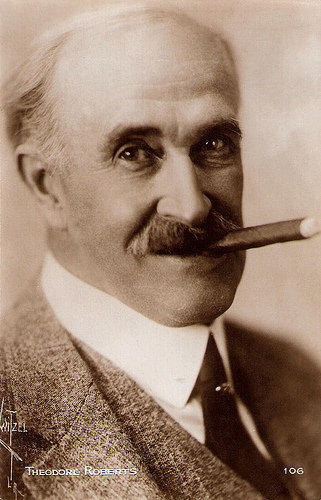
French postcard by Cinémagazine-Edition, no. 106. Photo: Albert Witzel, Los Angeles.
Grumpy
Theodore Roberts was born in 1861 in San Francisco, California, USA, as the son of a sea captain, Martin Rickard Roberts, and Mary Elisabeth Nowlin. He was a cousin of the stage actress Florence Roberts.
Roberts made his first appearance on stage in 1880. In the 1890s he acted with Fanny Davenport in her play Gismonda (1894) and later in The Bird of Paradise (1912) with actress Laurette Taylor.
In 1914 he made his film debut in the silent adventure-drama Call of the North (Oscar Apfel, Cecil B. deMille, 1914). It is based on a novel, The Conjuror's House; a Romance of the Free Forest by Stewart Edward White and its 1908 play adaptation The Call of the North by George Broadhurst. Robert Edeson starred in the play and reprised his role in this film.
Roberts became a regular on the Cecil B. DeMille team and appeared in 23 of DeMille's films, such as Joan the Woman (1916) with Geraldine Farrar , The Squaw Man (1918) with Elliott Dexter, Don't Change Your Husband (1919) with Gloria Swanson and Dexter, Male and Female (1919) with Swanson and Thomas Meighan, and The Affairs of Anatol (1921) with Swanson and Wallace Reid.
Roberts also acted in films by William DeMille, such as Miss Lulu Bett (1921) starring Lois Wilson, and Grumpy (1923), in which he played the title character.
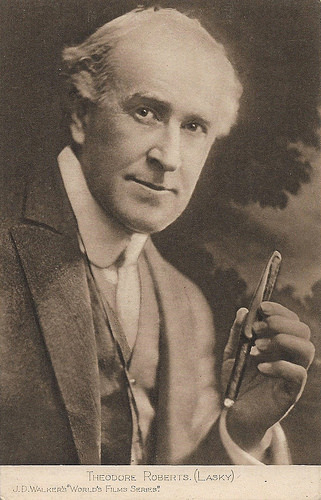
British postcard in J.D. Walker's "World's Film Series". Photo: Lasky.
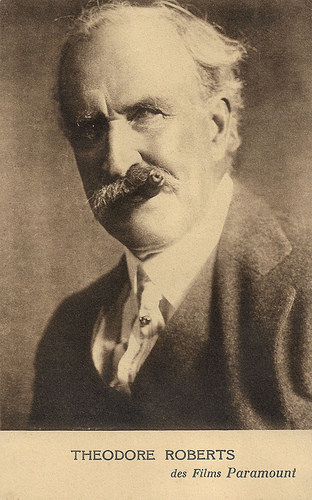
French postcard by Edition Paramount, Paris. Photo: Paramount.
Bitterness in his heart
Theodore Roberts is best remembered for his role as Moses in Cecil B. DeMille's silent version of the epic The Ten Commandments (1923).
The religious, epic film, written by Jeanie MacPherson, is divided into two parts: a prologue recreating the biblical story of the Exodus and a modern story concerning two brothers and their respective views of the Ten Commandments.
Lauded for its "immense and stupendous" scenes, use of Technicolor process, and parting of the Red Sea sequence, the expensive film proved to be a box-office hit upon release. It is the first in DeMille's biblical trilogy, followed by The King of Kings (Cecil B. DeMille, 1927) and The Sign of the Cross (Cecil B. DeMille, 1932).
Despite the success of the film, Roberts played in less films after 1923, until the end of the silent era. His final film was the silent romantic dram Locked Doors (William C. deMille, 1925) starring Betty Compson. The film is considered lost.
In 1928, Theodore Roberts died from uremic poisoning in Hollywood. He was 67. A well-known and well-loved actor, Roberts' funeral in Westlake Park was attended by nearly 2,000 people.
However, Roberts felt so much bitterness in his heart for his immediate relatives that he bequeathed his estate to a nephew (a commercial illustrator) in New York. The estate was valued at nearly $20,000, including a yacht valued at $10,000.
Several of Roberts' personal items were left to his friends William C. de Mille and his brother Cecil. Roberts claimed that during the worst times of his life, no one in his family offered a word of sympathy or any help at all. His only request was that he be laid to rest next to his beloved wife, actress Florence Smythe, who had passed away in 1925.
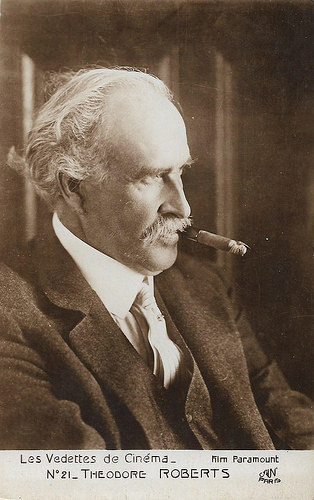
French postcard by A.N. Paris, in the Les Vedettes de Cinéma series, no. 21. Photo: Paramount.
Source: Wikipedia and .

French postcard by Cinémagazine-Edition, no. 106. Photo: Albert Witzel, Los Angeles.
Grumpy
Theodore Roberts was born in 1861 in San Francisco, California, USA, as the son of a sea captain, Martin Rickard Roberts, and Mary Elisabeth Nowlin. He was a cousin of the stage actress Florence Roberts.
Roberts made his first appearance on stage in 1880. In the 1890s he acted with Fanny Davenport in her play Gismonda (1894) and later in The Bird of Paradise (1912) with actress Laurette Taylor.
In 1914 he made his film debut in the silent adventure-drama Call of the North (Oscar Apfel, Cecil B. deMille, 1914). It is based on a novel, The Conjuror's House; a Romance of the Free Forest by Stewart Edward White and its 1908 play adaptation The Call of the North by George Broadhurst. Robert Edeson starred in the play and reprised his role in this film.
Roberts became a regular on the Cecil B. DeMille team and appeared in 23 of DeMille's films, such as Joan the Woman (1916) with Geraldine Farrar , The Squaw Man (1918) with Elliott Dexter, Don't Change Your Husband (1919) with Gloria Swanson and Dexter, Male and Female (1919) with Swanson and Thomas Meighan, and The Affairs of Anatol (1921) with Swanson and Wallace Reid.
Roberts also acted in films by William DeMille, such as Miss Lulu Bett (1921) starring Lois Wilson, and Grumpy (1923), in which he played the title character.

British postcard in J.D. Walker's "World's Film Series". Photo: Lasky.

French postcard by Edition Paramount, Paris. Photo: Paramount.
Bitterness in his heart
Theodore Roberts is best remembered for his role as Moses in Cecil B. DeMille's silent version of the epic The Ten Commandments (1923).
The religious, epic film, written by Jeanie MacPherson, is divided into two parts: a prologue recreating the biblical story of the Exodus and a modern story concerning two brothers and their respective views of the Ten Commandments.
Lauded for its "immense and stupendous" scenes, use of Technicolor process, and parting of the Red Sea sequence, the expensive film proved to be a box-office hit upon release. It is the first in DeMille's biblical trilogy, followed by The King of Kings (Cecil B. DeMille, 1927) and The Sign of the Cross (Cecil B. DeMille, 1932).
Despite the success of the film, Roberts played in less films after 1923, until the end of the silent era. His final film was the silent romantic dram Locked Doors (William C. deMille, 1925) starring Betty Compson. The film is considered lost.
In 1928, Theodore Roberts died from uremic poisoning in Hollywood. He was 67. A well-known and well-loved actor, Roberts' funeral in Westlake Park was attended by nearly 2,000 people.
However, Roberts felt so much bitterness in his heart for his immediate relatives that he bequeathed his estate to a nephew (a commercial illustrator) in New York. The estate was valued at nearly $20,000, including a yacht valued at $10,000.
Several of Roberts' personal items were left to his friends William C. de Mille and his brother Cecil. Roberts claimed that during the worst times of his life, no one in his family offered a word of sympathy or any help at all. His only request was that he be laid to rest next to his beloved wife, actress Florence Smythe, who had passed away in 1925.

French postcard by A.N. Paris, in the Les Vedettes de Cinéma series, no. 21. Photo: Paramount.
Source: Wikipedia and .
Published on November 08, 2018 22:00
November 7, 2018
Mary Poppins (1964)
In Walt Disney's musical-fantasy Mary Poppins (Robert Stevenson, 1964) live-action is successfully combined with animation. The songs by the Sherman Brothers are performed by a great cast with Julie Andrews in her film debut, Dick Van Dyke, David Tomlinson, and Glynis Johns. The film is based on the first book in P. L. Travers's series about magical nanny Mary Poppins, who employs music and adventure to help two neglected children become closer to their father. Mary Poppins received a total of 13 Academy Award nominations, including Best Picture – a record for any other film released by Walt Disney Studios – and won five, including the Best Actress Oscar for Julie Andrews. A sequel titled Mary Poppins Returns (Rob Marshall, 2018) with Emily Blunt as Mary is scheduled to be released next month, on 19 December 2018.
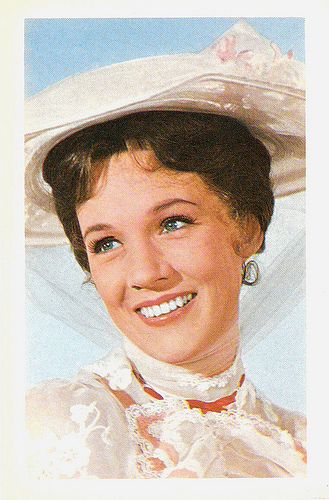
Vintage postcard. Photo: still from Mary Poppins (1964).

Spanish postcard by EdicionesTarje Fher/Ediciones Mandolina, 1964. Photo: Walt Disney Productions. Still from Mary Poppins (1964).

Spanish postcard by Ediciones Tarje Fher/Ediciones Mandolina, 1964. Photo: Walt Disney Productions. Still from Mary Poppins (1964).
Supercalifragilisticexpialidocious
In Edwardian London, 1910, Bert (played by Dick van Dyke), a Cockney chimneysweep, entertains a crowd as a one-man band when he senses a change in the wind. Afterwards, he directly addresses the audience, and gives them a tour of Cherry Tree Lane, stopping outside the Banks family’s home. George Banks ( David Tomlinson ) returns home to learn from his wife, Winifred ( Glynis Johns ), that Katie Nanna (Elsa Lanchester) has left their service after Jane (Karen Dotrice) and Michael (Matthew Garber) ran away again.
Jane and Michael are returned shortly after by Constable Jones (Arthur Treacher), who reveals the children were chasing a lost kite. The children ask their father to help build a better kite, but he dismisses them. Taking it upon himself to hire a new nanny, the uptight Mr. Banks advertises for a stern, no-nonsense nanny. Instead, Jane and Michael present their own advertisement for a kinder, sweeter nanny. Mr. Banks rips up the letter, and throws the scraps in the fireplace, but the remains of the advertisement magically float up, and out into the air.
The next day, a number of elderly, sour-faced nannies wait outside the Banks' home, but a strong gust of wind blows them away, and Jane and Michael witness a young nanny descending from the sky using her umbrella. Presenting herself to Mr. Banks, Mary Poppins ( Julie Andrews ) calmly produces the children's restored advertisement, and agrees with its requests, but promises the astonished banker she will be firm with his children. As Mr. Banks puzzles over the advertisement's return, Mary Poppins hires herself, and convinces him it was originally his idea. She meets the children, then helps them tidy their nursery through song, before heading out for a walk in the park.
Outside, they meet Bert, working as a sidewalk artist. Mary Poppins uses her magic to hop the group into one of Bert's chalk drawings. While the children ride on a carousel, Mary Poppins and Bert go on a leisurely stroll. Mary Poppins later enchants the carousel horses, and participates in a horse race, which she wins. While being asked to describe her victory, Mary Poppins announces the nonsense word "Supercalifragilisticexpialidocious".
Embarking on a series of fantastical adventures with Mary and Bert, the children try to pass on some of their nanny's sunny attitude to their preoccupied parents. At the end of the film, the wind changes, meaning Mary Poppins must leave. With her work done, Mary Poppins flies away, with Bert bidding her farewell, telling her not to stay away too long.

French postcard by Les Presses de Belleville, Paris, no. 101. Photo: Walt Disney Productions. Publicity still for Mary Poppins (Robert Stevenson, 1964).
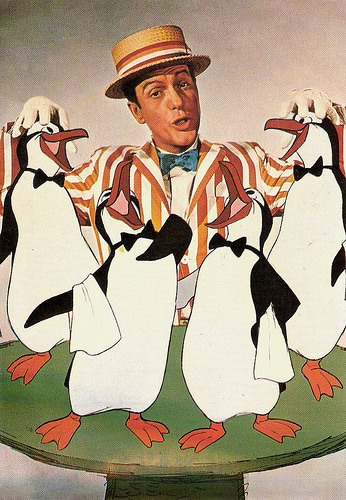
French postcard by Les Presses de Belleville, Paris, no. 103. Photo: Walt Disney Productions. Publicity still for Mary Poppins (Robert Stevenson, 1964).

French postcard by Les Presses de Belleville, Paris, no. 107. Photo: Walt Disney Productions. Publicity still for Mary Poppins (Robert Stevenson, 1964).
Giving his voice to Mary's talking umbrella
Julie Andrews got the prime role of Mary Poppins soon after she was passed over by Jack L. Warner and replaced with Audrey Hepburn for the role of Eliza Doolittle in his screen adaptation of My Fair Lady, even though Andrews had originated the role on Broadway. When Disney first approached Andrews about taking on the role, Andrews was three months pregnant and therefore was not sure she should take it. Disney assured her that the crew would be fine with waiting to begin filming until after she had given birth so that she could play the part.
Julie Andrews also provided the voice in two other sections of the film: during A Spoonful of Sugar, she provided the whistling harmony for the robin, and she was also among the chorus performing as the animated Pearly Band during Supercalifragilisticexpialidocious.
David Tomlinson , besides playing Mr. Banks, provided the voice of Mary's talking umbrella and numerous other voice-over parts (including that of Admiral Boom's first mate). During the Jolly Holiday sequence, the three singing Cockney geese were all voiced by Marni Nixon, a regular aural substitute for actresses with substandard singing voices. Nixon would later provide the singing voice for Hepburn in My Fair Lady and play one of Andrews' fellow nuns in The Sound of Music.
Andrews later beat Hepburn for the Best Actress Award at the Golden Globes for their respective roles. Andrews would also win the Academy Award for Best Actress for her role. Hepburn did not receive a nomination. Richard Sherman, one of the songwriters, also voiced a penguin as well as one of the Pearlies. Robert Sherman dubbed the speaking voice for Jane Darwell who played the 'Bird Woman', an old woman who sells breadcrumbs for the pigeons on the steps of St Paul's Cathedral. It was to be her last screen appearance. Darwell's voice was too weak to be heard in the soundtrack and Sherman's voice is heard saying her only line: "Feed the Birds, Tuppence a bag."
Disney cast Dick Van Dyke in the key supporting role of Bert after seeing his work on The Dick Van Dyke Show. After winning the role of Bert, Van Dyke lobbied to also play the senior Mr. Dawes, but Disney originally felt he was too young for the part. Van Dyke eventually won Disney over after a screen test. In the end credits cast list, the actor playing Mr. Dawes, Sr. is initially shown as NAVCKID KEYD, then the letters unscramble themselves to show that this is a second role played by Dick Van Dyke. Although he is fondly remembered for this film, Van Dyke's attempt at a Cockney accent is regarded as one of the worst film accents in history.
The film was a major hit, worldwide, and quickly achieved the legendary status it holds today. Ben Burgraff at IMDb : "Mary Poppins is one of that select group of films that can truly be called 'Classic', a project conceived in love and filled with so much child-like wonder that it will never grow old or 'out-of-date'. Certainly the crowning achievement of Walt Disney's remarkable career, both story-wise and technically, the film remains an unsurpassed achievement!"
Dan Jardine at AllMovie: "The story's attack on the materialistic values and staid lives of turn-of-the-century England is undercut by the Disney-like romanticizing of the lives of the working class, particularly the chimney sweeps. The children give predictably too-cute performances, but the direction by Robert Stevenson keeps things moving briskly enough that we don't get stuck in sticky sweetness. The entire set was constructed indoors and it shows: the 'outdoor' scenes are bathed in a dull gray light. Still, there are a number of unforgettable song-and-dance sequences that stand the test of time, and the tale's overall subversiveness is distinctly appealing."
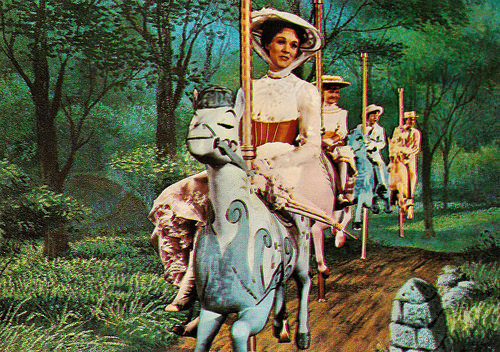
French postcard by Les Presses de Belleville, Paris, no. 104. Photo: Walt Disney Productions. Publicity still for Mary Poppins (Robert Stevenson, 1964).
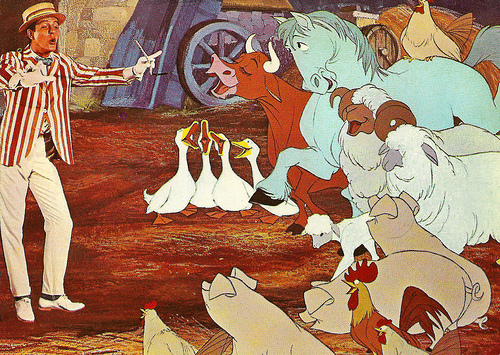
French postcard by Les Presses de Belleville, Paris, no. 108. Photo: Walt Disney Productions. Publicity still for Mary Poppins (Robert Stevenson, 1964).
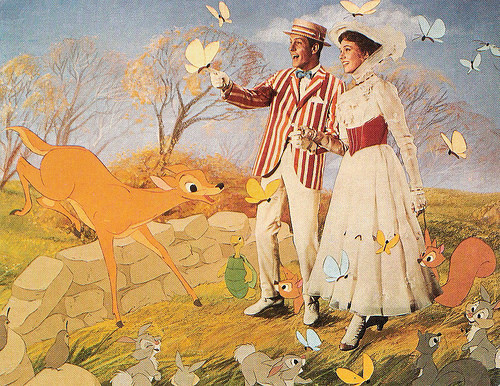
French postcard. Photo: Walt Disney Productions. Publicity still for Mary Poppins (Robert Stevenson, 1964).
Sources: Ben Burgraff (IMDb), Dan Jardine (AllMovie), Hal Erickson (AllMovie), Wikipedia and IMDb.

Vintage postcard. Photo: still from Mary Poppins (1964).

Spanish postcard by EdicionesTarje Fher/Ediciones Mandolina, 1964. Photo: Walt Disney Productions. Still from Mary Poppins (1964).

Spanish postcard by Ediciones Tarje Fher/Ediciones Mandolina, 1964. Photo: Walt Disney Productions. Still from Mary Poppins (1964).
Supercalifragilisticexpialidocious
In Edwardian London, 1910, Bert (played by Dick van Dyke), a Cockney chimneysweep, entertains a crowd as a one-man band when he senses a change in the wind. Afterwards, he directly addresses the audience, and gives them a tour of Cherry Tree Lane, stopping outside the Banks family’s home. George Banks ( David Tomlinson ) returns home to learn from his wife, Winifred ( Glynis Johns ), that Katie Nanna (Elsa Lanchester) has left their service after Jane (Karen Dotrice) and Michael (Matthew Garber) ran away again.
Jane and Michael are returned shortly after by Constable Jones (Arthur Treacher), who reveals the children were chasing a lost kite. The children ask their father to help build a better kite, but he dismisses them. Taking it upon himself to hire a new nanny, the uptight Mr. Banks advertises for a stern, no-nonsense nanny. Instead, Jane and Michael present their own advertisement for a kinder, sweeter nanny. Mr. Banks rips up the letter, and throws the scraps in the fireplace, but the remains of the advertisement magically float up, and out into the air.
The next day, a number of elderly, sour-faced nannies wait outside the Banks' home, but a strong gust of wind blows them away, and Jane and Michael witness a young nanny descending from the sky using her umbrella. Presenting herself to Mr. Banks, Mary Poppins ( Julie Andrews ) calmly produces the children's restored advertisement, and agrees with its requests, but promises the astonished banker she will be firm with his children. As Mr. Banks puzzles over the advertisement's return, Mary Poppins hires herself, and convinces him it was originally his idea. She meets the children, then helps them tidy their nursery through song, before heading out for a walk in the park.
Outside, they meet Bert, working as a sidewalk artist. Mary Poppins uses her magic to hop the group into one of Bert's chalk drawings. While the children ride on a carousel, Mary Poppins and Bert go on a leisurely stroll. Mary Poppins later enchants the carousel horses, and participates in a horse race, which she wins. While being asked to describe her victory, Mary Poppins announces the nonsense word "Supercalifragilisticexpialidocious".
Embarking on a series of fantastical adventures with Mary and Bert, the children try to pass on some of their nanny's sunny attitude to their preoccupied parents. At the end of the film, the wind changes, meaning Mary Poppins must leave. With her work done, Mary Poppins flies away, with Bert bidding her farewell, telling her not to stay away too long.

French postcard by Les Presses de Belleville, Paris, no. 101. Photo: Walt Disney Productions. Publicity still for Mary Poppins (Robert Stevenson, 1964).

French postcard by Les Presses de Belleville, Paris, no. 103. Photo: Walt Disney Productions. Publicity still for Mary Poppins (Robert Stevenson, 1964).

French postcard by Les Presses de Belleville, Paris, no. 107. Photo: Walt Disney Productions. Publicity still for Mary Poppins (Robert Stevenson, 1964).
Giving his voice to Mary's talking umbrella
Julie Andrews got the prime role of Mary Poppins soon after she was passed over by Jack L. Warner and replaced with Audrey Hepburn for the role of Eliza Doolittle in his screen adaptation of My Fair Lady, even though Andrews had originated the role on Broadway. When Disney first approached Andrews about taking on the role, Andrews was three months pregnant and therefore was not sure she should take it. Disney assured her that the crew would be fine with waiting to begin filming until after she had given birth so that she could play the part.
Julie Andrews also provided the voice in two other sections of the film: during A Spoonful of Sugar, she provided the whistling harmony for the robin, and she was also among the chorus performing as the animated Pearly Band during Supercalifragilisticexpialidocious.
David Tomlinson , besides playing Mr. Banks, provided the voice of Mary's talking umbrella and numerous other voice-over parts (including that of Admiral Boom's first mate). During the Jolly Holiday sequence, the three singing Cockney geese were all voiced by Marni Nixon, a regular aural substitute for actresses with substandard singing voices. Nixon would later provide the singing voice for Hepburn in My Fair Lady and play one of Andrews' fellow nuns in The Sound of Music.
Andrews later beat Hepburn for the Best Actress Award at the Golden Globes for their respective roles. Andrews would also win the Academy Award for Best Actress for her role. Hepburn did not receive a nomination. Richard Sherman, one of the songwriters, also voiced a penguin as well as one of the Pearlies. Robert Sherman dubbed the speaking voice for Jane Darwell who played the 'Bird Woman', an old woman who sells breadcrumbs for the pigeons on the steps of St Paul's Cathedral. It was to be her last screen appearance. Darwell's voice was too weak to be heard in the soundtrack and Sherman's voice is heard saying her only line: "Feed the Birds, Tuppence a bag."
Disney cast Dick Van Dyke in the key supporting role of Bert after seeing his work on The Dick Van Dyke Show. After winning the role of Bert, Van Dyke lobbied to also play the senior Mr. Dawes, but Disney originally felt he was too young for the part. Van Dyke eventually won Disney over after a screen test. In the end credits cast list, the actor playing Mr. Dawes, Sr. is initially shown as NAVCKID KEYD, then the letters unscramble themselves to show that this is a second role played by Dick Van Dyke. Although he is fondly remembered for this film, Van Dyke's attempt at a Cockney accent is regarded as one of the worst film accents in history.
The film was a major hit, worldwide, and quickly achieved the legendary status it holds today. Ben Burgraff at IMDb : "Mary Poppins is one of that select group of films that can truly be called 'Classic', a project conceived in love and filled with so much child-like wonder that it will never grow old or 'out-of-date'. Certainly the crowning achievement of Walt Disney's remarkable career, both story-wise and technically, the film remains an unsurpassed achievement!"
Dan Jardine at AllMovie: "The story's attack on the materialistic values and staid lives of turn-of-the-century England is undercut by the Disney-like romanticizing of the lives of the working class, particularly the chimney sweeps. The children give predictably too-cute performances, but the direction by Robert Stevenson keeps things moving briskly enough that we don't get stuck in sticky sweetness. The entire set was constructed indoors and it shows: the 'outdoor' scenes are bathed in a dull gray light. Still, there are a number of unforgettable song-and-dance sequences that stand the test of time, and the tale's overall subversiveness is distinctly appealing."

French postcard by Les Presses de Belleville, Paris, no. 104. Photo: Walt Disney Productions. Publicity still for Mary Poppins (Robert Stevenson, 1964).

French postcard by Les Presses de Belleville, Paris, no. 108. Photo: Walt Disney Productions. Publicity still for Mary Poppins (Robert Stevenson, 1964).

French postcard. Photo: Walt Disney Productions. Publicity still for Mary Poppins (Robert Stevenson, 1964).
Sources: Ben Burgraff (IMDb), Dan Jardine (AllMovie), Hal Erickson (AllMovie), Wikipedia and IMDb.
Published on November 07, 2018 22:00
November 6, 2018
Priscilla Dean
Priscilla Dean (1896-1987) was an American actress of the silent screen. Between 1912 and 1928, she appeared in some 70 silent films, and later in five sound films. She is best known for her Universal films under the direction of horror specialist Tod Browning.
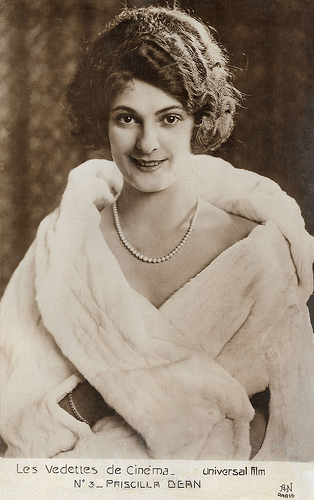
French postcard by A.N., Paris, in the Les Vedettes de Cinéma series, no. 3. Photo: Universal Film.
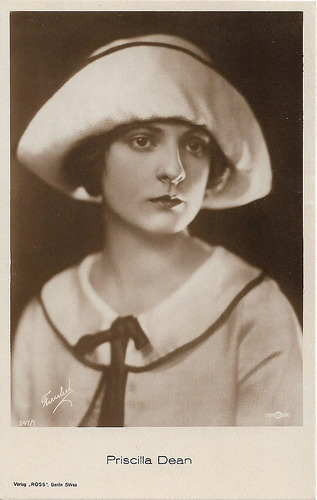
German postcard by Ross Verlag, no. 548/1, 1919-1924. Photo: Roman Freulich / Unfilman.
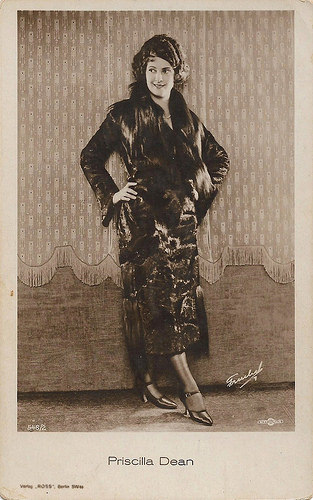
German postcard by Ross Verlag, no. 548/2, 1919-1924. Photo: Roman Freulich / Unfilman.
David Wark Griffith
Priscilla Dean was born in 1896 in New York City as the daughter of theatre actors. Her mother was popular stage actress May Preston Dean.
From when she was four, Priscilla played in her parents' productions. As a child, she pursued a stage career at the same time as being educated at a convent school until the age of fourteen. By age 10, she was a seasoned professional.
Dean made her film debut and appeared in two short films, released in 1912. One of them was directed by D. W. Griffith for the Biograph company, A Blot under 'Scutcheon (1912).
Until 1928, she contributed to 68 American silent films, including many short films directed by Jack Dillon made in the mid-1910s for the Vogue Company.
From 1916 onwards, she worked for IMP, which was later merged with other film companies into Universal. She played the female lead in the Eddie Lyons & Lee Moran comedies, directed by Louis Chaudet for Nestor, another company which was merged into Universal.
In 1917 she acted in films by Lois Weber such as Even As You and I (1917) and The Hand That Rocks the Cradle (1917).
Her appearance in the action serial The Gray Ghost (Stuart Paton, 1917) opposite Eddie Polo propelled her to stardom, and she began appearing in many of Universal's most prestigious productions.
Greta de Groat at Unsung Divas : "Priscilla Dean was a very unlikely diva. Her photos show a plain but cheerful looking woman, with rather heavy features, a crooked grin, and an unfashionably curvaceous figure. But on screen her intensity is unmatched. "
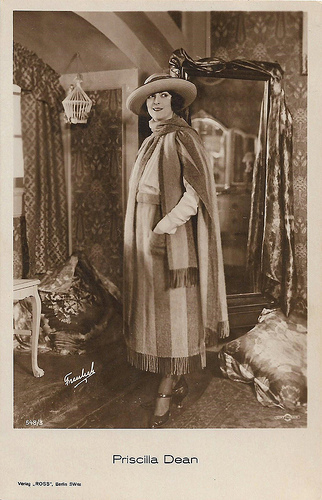
German postcard by Ross Verlag, no. 548/3, 1919-1924. Photo: Roman Freulich / Unfilman.
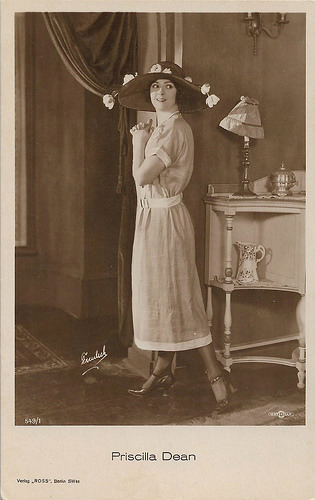
German postcard by Ross Verlag, no. 549/1, 1919-1924. Photo: Roman Freulich / Unfilman.
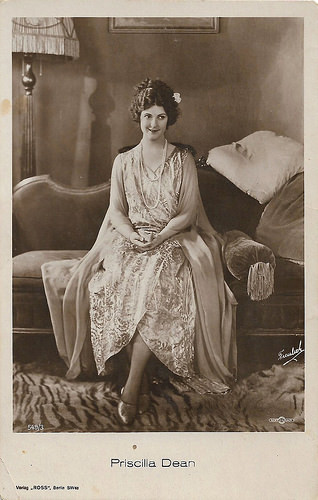
German postcard by Ross Verlag, no. 549/3, 1919-1924. Photo: Roman Freulich / Unfilman.
Tod Browning
Priscilla Dean is best known for her participation, between 1918 and 1923, in nine Universal films by Tod Browning. These films include The Wicked Darling (1919) in which she played a s pair of pickpockets with Lon Chaney , The Virgin of Stamboul (1920) with Wallace Beery, Outside the Law (1920), with Lon Chaney , Under Two Flags (1922), and White Tiger (1923), with Raymond Griffith.
Browning unleashed her talent. Her performance in Outside the Law (1920) is "startlingly fierce", according to Greta de Groat. In the French Foreign Legion melodrama Under two Flags (1922) she played Cigarette, a role re-created in a sound version by Claudette Colbert.
In The Virgin of Stamboul and Outside the Law, Dean played together with Wheeler Oakman, who was also under contract at Universal an was for a time her husband.
After 1923, Dean worked for several companies: she did quite a few films at Metropolitan, a few shorts at Hal Roach such as Slipping Wives (Fred Guiol, 1927), with Laurel & Hardy , and one or two productions at Hunt Stromberg and Columbia.
The coming of sound damaged her career. By the early 1930s she was appearing in low-budget films for small independent studios. Dean retired permanently from the screen after five talking pictures (three shorts in 1931 and two feature films in 1932).
Her last film was Klondike (Phil Rosen, 1932) with Thelma Todd and Lyle Talbot. Great de Groat: "Her starring career was brief, but there was nobody else quite like her."
Priscilla Dean was first married to Wheeler Oakman but they divorced in the mid-1920s. In 1928, she married Leslie Arnold in Mexico. Arnold was divorced, but one court called this invalid, making him a bigamist, but in the end that verdict was overruled.
Lt. Leslie Arnold had made history by flying around the world in 1924. Dean and Arnold remained married until his death in the 1960s. They had no children.
In 1987, Priscilla Dean died at her home in Leonia, New Jersey, after the complications of a fall one year earlier. She was 91.
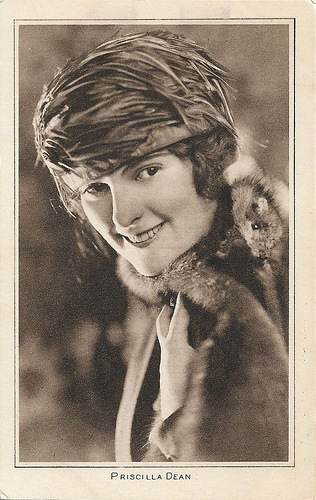
British postcard.
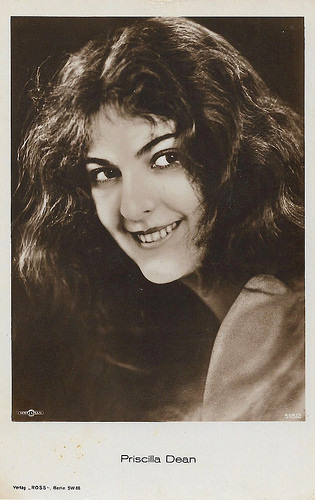
German postcard by Ross Verlag, no. 518/2, 1919-1924. Photo: Unfilman.
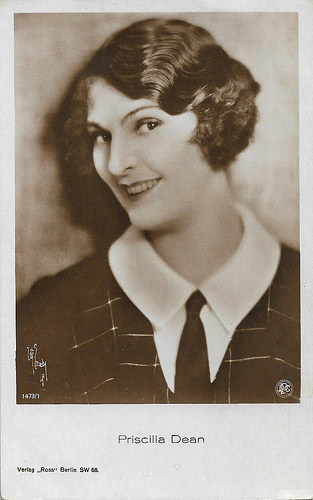
German postcard by Ross Verlag, no. 1473/1, 1927-1928. Photo: Walter F. Seely, Los Angeles / P.D.C.
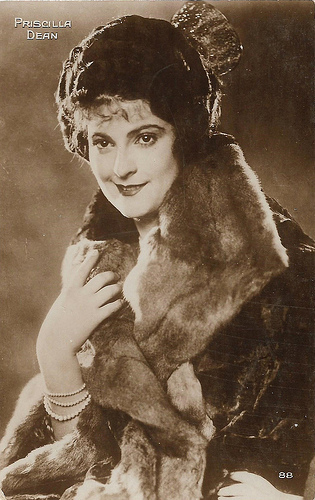
French postcard by Editions Cinémagazine, no. 88.
Sources: Greta de Groat (Unsung Divas), Michael Barson (Encyclopaedia Britannica), Silent Hollywood, Los Angeles Times, Wikipedia (Italian and English) and .

French postcard by A.N., Paris, in the Les Vedettes de Cinéma series, no. 3. Photo: Universal Film.

German postcard by Ross Verlag, no. 548/1, 1919-1924. Photo: Roman Freulich / Unfilman.

German postcard by Ross Verlag, no. 548/2, 1919-1924. Photo: Roman Freulich / Unfilman.
David Wark Griffith
Priscilla Dean was born in 1896 in New York City as the daughter of theatre actors. Her mother was popular stage actress May Preston Dean.
From when she was four, Priscilla played in her parents' productions. As a child, she pursued a stage career at the same time as being educated at a convent school until the age of fourteen. By age 10, she was a seasoned professional.
Dean made her film debut and appeared in two short films, released in 1912. One of them was directed by D. W. Griffith for the Biograph company, A Blot under 'Scutcheon (1912).
Until 1928, she contributed to 68 American silent films, including many short films directed by Jack Dillon made in the mid-1910s for the Vogue Company.
From 1916 onwards, she worked for IMP, which was later merged with other film companies into Universal. She played the female lead in the Eddie Lyons & Lee Moran comedies, directed by Louis Chaudet for Nestor, another company which was merged into Universal.
In 1917 she acted in films by Lois Weber such as Even As You and I (1917) and The Hand That Rocks the Cradle (1917).
Her appearance in the action serial The Gray Ghost (Stuart Paton, 1917) opposite Eddie Polo propelled her to stardom, and she began appearing in many of Universal's most prestigious productions.
Greta de Groat at Unsung Divas : "Priscilla Dean was a very unlikely diva. Her photos show a plain but cheerful looking woman, with rather heavy features, a crooked grin, and an unfashionably curvaceous figure. But on screen her intensity is unmatched. "

German postcard by Ross Verlag, no. 548/3, 1919-1924. Photo: Roman Freulich / Unfilman.

German postcard by Ross Verlag, no. 549/1, 1919-1924. Photo: Roman Freulich / Unfilman.

German postcard by Ross Verlag, no. 549/3, 1919-1924. Photo: Roman Freulich / Unfilman.
Tod Browning
Priscilla Dean is best known for her participation, between 1918 and 1923, in nine Universal films by Tod Browning. These films include The Wicked Darling (1919) in which she played a s pair of pickpockets with Lon Chaney , The Virgin of Stamboul (1920) with Wallace Beery, Outside the Law (1920), with Lon Chaney , Under Two Flags (1922), and White Tiger (1923), with Raymond Griffith.
Browning unleashed her talent. Her performance in Outside the Law (1920) is "startlingly fierce", according to Greta de Groat. In the French Foreign Legion melodrama Under two Flags (1922) she played Cigarette, a role re-created in a sound version by Claudette Colbert.
In The Virgin of Stamboul and Outside the Law, Dean played together with Wheeler Oakman, who was also under contract at Universal an was for a time her husband.
After 1923, Dean worked for several companies: she did quite a few films at Metropolitan, a few shorts at Hal Roach such as Slipping Wives (Fred Guiol, 1927), with Laurel & Hardy , and one or two productions at Hunt Stromberg and Columbia.
The coming of sound damaged her career. By the early 1930s she was appearing in low-budget films for small independent studios. Dean retired permanently from the screen after five talking pictures (three shorts in 1931 and two feature films in 1932).
Her last film was Klondike (Phil Rosen, 1932) with Thelma Todd and Lyle Talbot. Great de Groat: "Her starring career was brief, but there was nobody else quite like her."
Priscilla Dean was first married to Wheeler Oakman but they divorced in the mid-1920s. In 1928, she married Leslie Arnold in Mexico. Arnold was divorced, but one court called this invalid, making him a bigamist, but in the end that verdict was overruled.
Lt. Leslie Arnold had made history by flying around the world in 1924. Dean and Arnold remained married until his death in the 1960s. They had no children.
In 1987, Priscilla Dean died at her home in Leonia, New Jersey, after the complications of a fall one year earlier. She was 91.

British postcard.

German postcard by Ross Verlag, no. 518/2, 1919-1924. Photo: Unfilman.

German postcard by Ross Verlag, no. 1473/1, 1927-1928. Photo: Walter F. Seely, Los Angeles / P.D.C.

French postcard by Editions Cinémagazine, no. 88.
Sources: Greta de Groat (Unsung Divas), Michael Barson (Encyclopaedia Britannica), Silent Hollywood, Los Angeles Times, Wikipedia (Italian and English) and .
Published on November 06, 2018 22:00
Paul van Yperen's Blog
- Paul van Yperen's profile
- 13 followers
Paul van Yperen isn't a Goodreads Author
(yet),
but they
do have a blog,
so here are some recent posts imported from
their feed.



